Forums
- Forums
- Axis And Allies Forum
- General Discussion
- Aviation News
Aviation News
Post a reply
- Go to Previous topic
- Go to Next topic
- Go to Welcome
- Go to Introduce Yourself
- Go to General Discussion
- Go to Screenshots, Images and Videos
- Go to Off topic
- Go to Works in Progress
- Go to Skinning Tips / Tutorials
- Go to Skin Requests
- Go to IJAAF Library
- Go to Luftwaffe Library
- Go to RAF Library
- Go to USAAF / USN Library
- Go to Misc Library
- Go to The Ops Room
- Go to Made in Germany
- Go to Campaigns and Missions
- Go to Works in Progress
- Go to Juri's Air-Raid Shelter
- Go to Campaigns and Missions
- Go to Works in Progress
- Go to Skinpacks
- Go to External Projects Discussion
- Go to Books & Resources
-
 Main AdminA U.S. Air Force F-35A Lightning II from Hill Air Force Base, Utah, taxis for take-off Nov. 16, 2017, at Kadena Air Base, Japan. The F-35A is being deployed under U.S. PACOM?s theater security package (TSP) program, which has been in operation since 2004. This long-planned deployment is designed to demonstrate the continuing U.S. commitment to stability and security in the region. (U.S. Air Force photo by Airman 1st Class Greg Erwin)
Main AdminA U.S. Air Force F-35A Lightning II from Hill Air Force Base, Utah, taxis for take-off Nov. 16, 2017, at Kadena Air Base, Japan. The F-35A is being deployed under U.S. PACOM?s theater security package (TSP) program, which has been in operation since 2004. This long-planned deployment is designed to demonstrate the continuing U.S. commitment to stability and security in the region. (U.S. Air Force photo by Airman 1st Class Greg Erwin)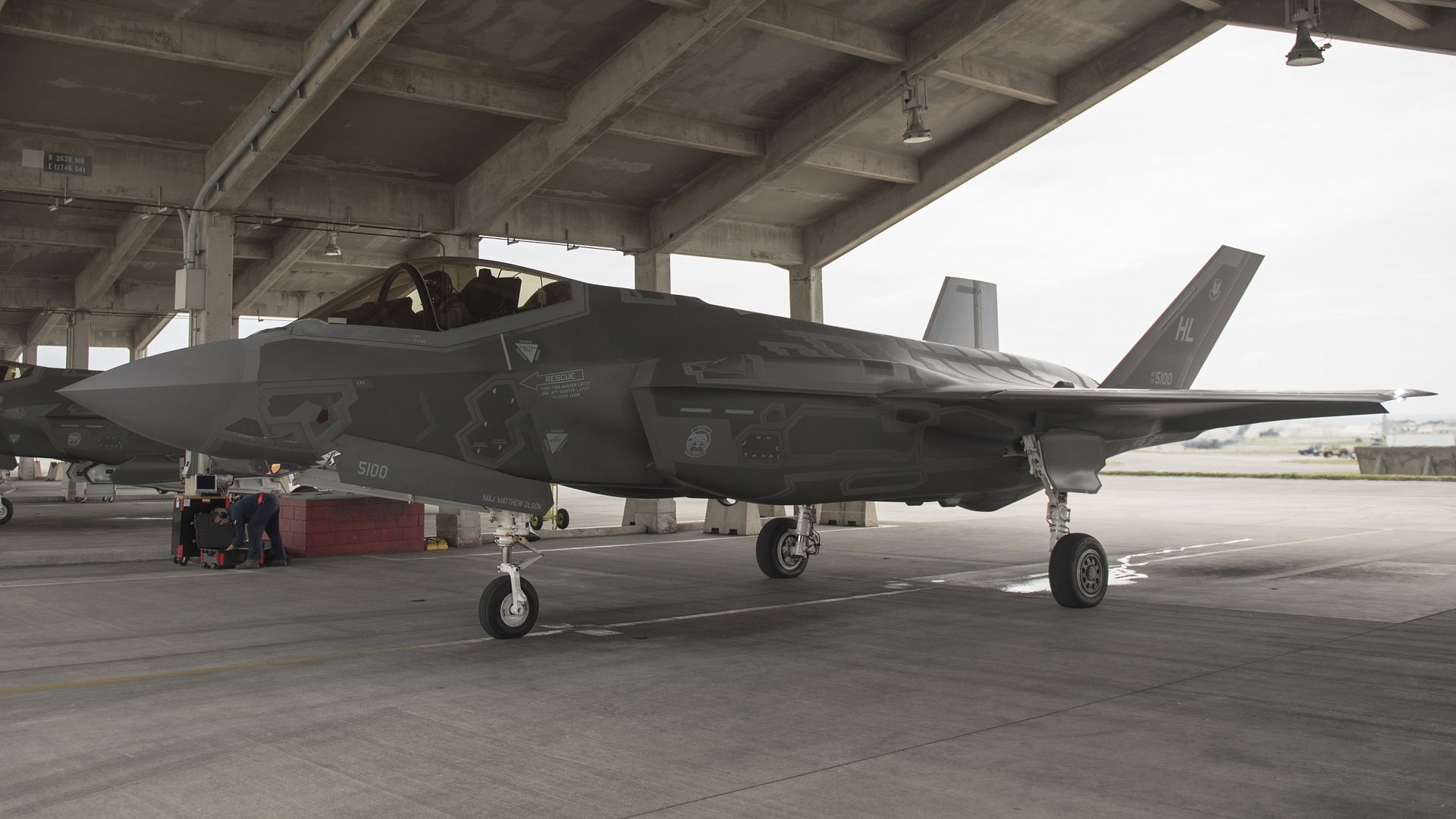
A U-2 Dragon Lady pilot prepares to land on the runway at Al Dhafra Air Base, United Arab Emirates, Nov. 16, 2017. The U-2's are based at the 9th Reconnaissance Wing, Beale Air Force Base, California, but are rotated to operational detachments worldwide. (U.S. Air National Guard photo by Staff Sgt. Colton Elliott)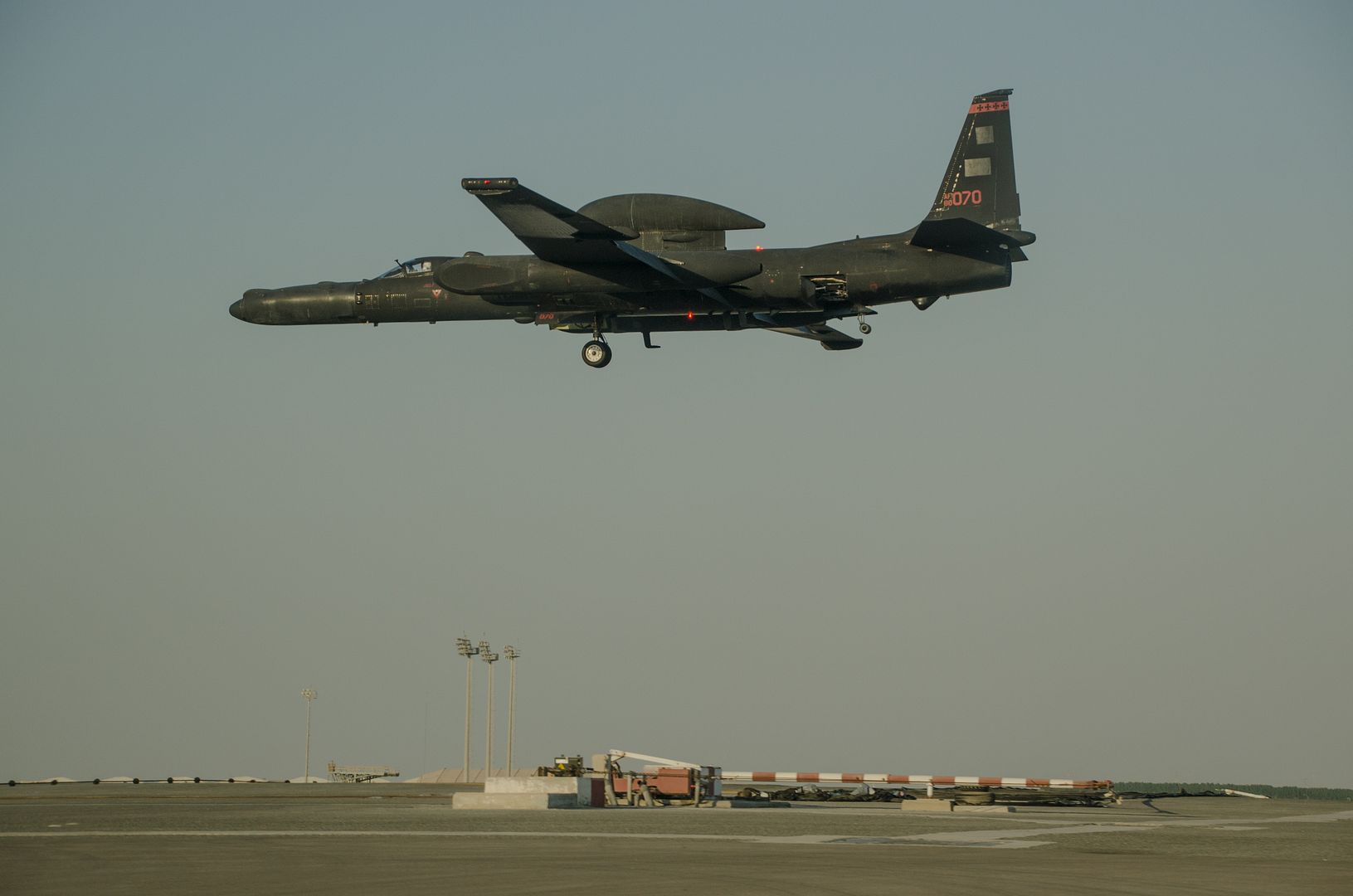
U.S. Marines with Marine Fighter Attack Squadron (VMFA) 121 conduct hot refuel on F-35B Lightning II aircraft while wearing Mission Oriented Protective Posture gear level four at Marine Corps Air Station Iwakuni, Japan, Nov. 15, 2017. A hot refuel is a fast-paced fueling method that allows aircraft to take in fuel while powered up, which gets them back to the fight quicker. Executing missions on time and being faster than the enemy is a vital aspect to the Marine Corps, and exercises like these assure that Marines can keep working quickly no matter what environment they?re forced to work in. (U.S. Marine Corps photo by Cpl. Carlos Jimenez)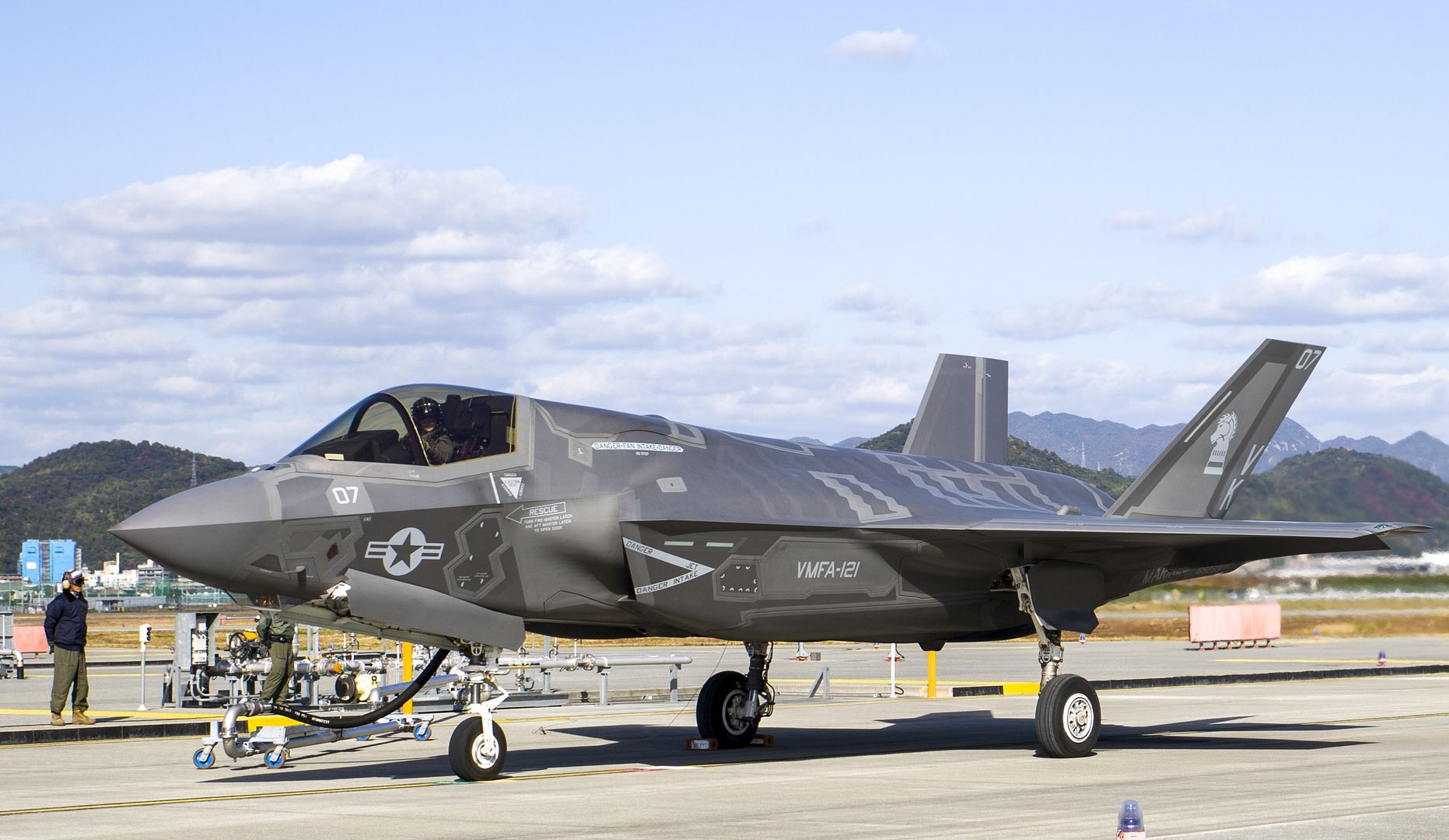
MELBOURNE, Fla. and ROBINS AIR FORCE BASE, Ga. ? Nov. 17, 2017 ? The U.S. Air Force has awarded Northrop Grumman Corporation (NYSE: NOC) a 12-month, $349.6 million contract for Total System Support Responsibility (TSSR) of the E-8C Joint Surveillance Target Attack Radar System (Joint STARS) fleet. The integrated logistics support contract covers TSSR Period Year 18, which began, Nov. 1, 2017, and concludes, Oct. 31, 2018
Under the Joint STARS TSSR program, Northrop Grumman is partnered with the Air Force Life Cycle Management Center to provide integrated logistics support to the 116th and 461st Air Control Wings (ACW) for all facets of sustainment and support of the Joint STARS fleet at Robins Air Force Base and forward operating locations overseas.
This is the 18th TSSR contract renewal for Northrop Grumman as part of the Joint STARS program. The company will continue providing program management, engineering technical support, supply chain and spares management, aircrew training, technical data and customer support with the objectives of maximizing aircraft available for operational and training use and reducing program cost.
?Our 32-year Joint STARS partnership with the Air Force provides us with an in-depth understanding of this powerful mission domain. Over several decades, we have responded to this ever-evolving battlespace by affordably adding 27 different capabilities. We continue to collaborate closely with our customer to keep the high-demand E-8C fleet available and mission capable -- ahead of emerging threats to support our combatant commanders,? said Bryan Lima, director, manned C2ISR program, Northrop Grumman Aerospace Systems.
?The Air Force and Northrop Grumman will continue to work to increase aircraft availability while reducing cost on the Joint STARS system to provide the best value for our customers and to deliver this critical capability to our combatant commanders,? said Colonel Ray Wier, System Program Manager, C2ISR Division, Battle Management Directorate, Air Force Life Cycle Management Center, U.S. Air Force.
Joint STARS offers battlefield commanders real-time situational information, while simultaneously transmitting target locations to aircraft and ground strike forces. Joint STARS is the only platform in the U.S. arsenal that combines accurate wide-area moving target detection with synthetic aperture radar imagery to locate, classify and track ground targets in all weather conditions from standoff distances. The fleet has flown over 130,000 combat mission hours in support of CENTCOM since September 11, 2001.
The 116th ACW and 461st ACW are part of a 2,500 person total force organization comprised of Georgia Air National Guard and active duty Air Force Airmen. In September 2017, the 461st Air Control Wing?s Crew Four was honored by the Air Force Association as the 2016 Airborne Battle Management (ABM) Crew of the Year. The Joint STARS team has won the ABM crew award 15 of the 16 years that it has been awarded.
In addition to work at Robins Air Force Base, TSSR is supported by employees and partners at the Northrop Grumman Manned Aircraft Design Center of Excellence in Melbourne, Florida, the Lake Charles Maintenance and Modification Center, in Lake Charles, Louisiana, and more than 30 major suppliers across the United States.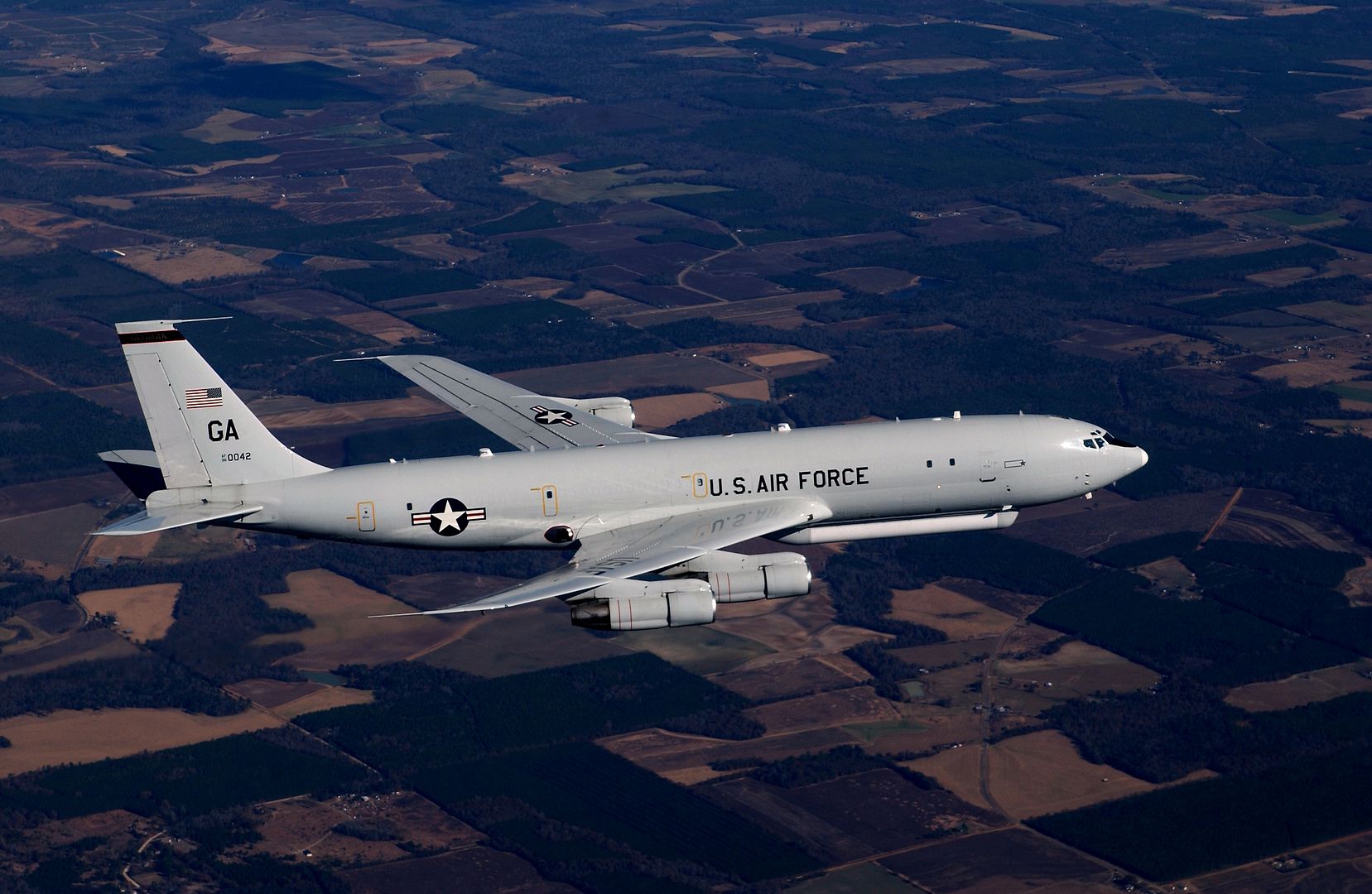
-
 Main AdminAn E-3 Sentry Airborne Warning and Control System aircraft is shown on the flightline at Al Dhafra Air Base, United Arab Emirates, Nov. 17. The aircraft is assigned to the 380th Air Expeditionary Wing which supports operations Iraqi Freedom, Enduring Freedom and the Combined Joint Task Force-Horn of Africa. (U.S. Air National Guard Photo's by Staff Sgt. Colton Elliott)
Main AdminAn E-3 Sentry Airborne Warning and Control System aircraft is shown on the flightline at Al Dhafra Air Base, United Arab Emirates, Nov. 17. The aircraft is assigned to the 380th Air Expeditionary Wing which supports operations Iraqi Freedom, Enduring Freedom and the Combined Joint Task Force-Horn of Africa. (U.S. Air National Guard Photo's by Staff Sgt. Colton Elliott)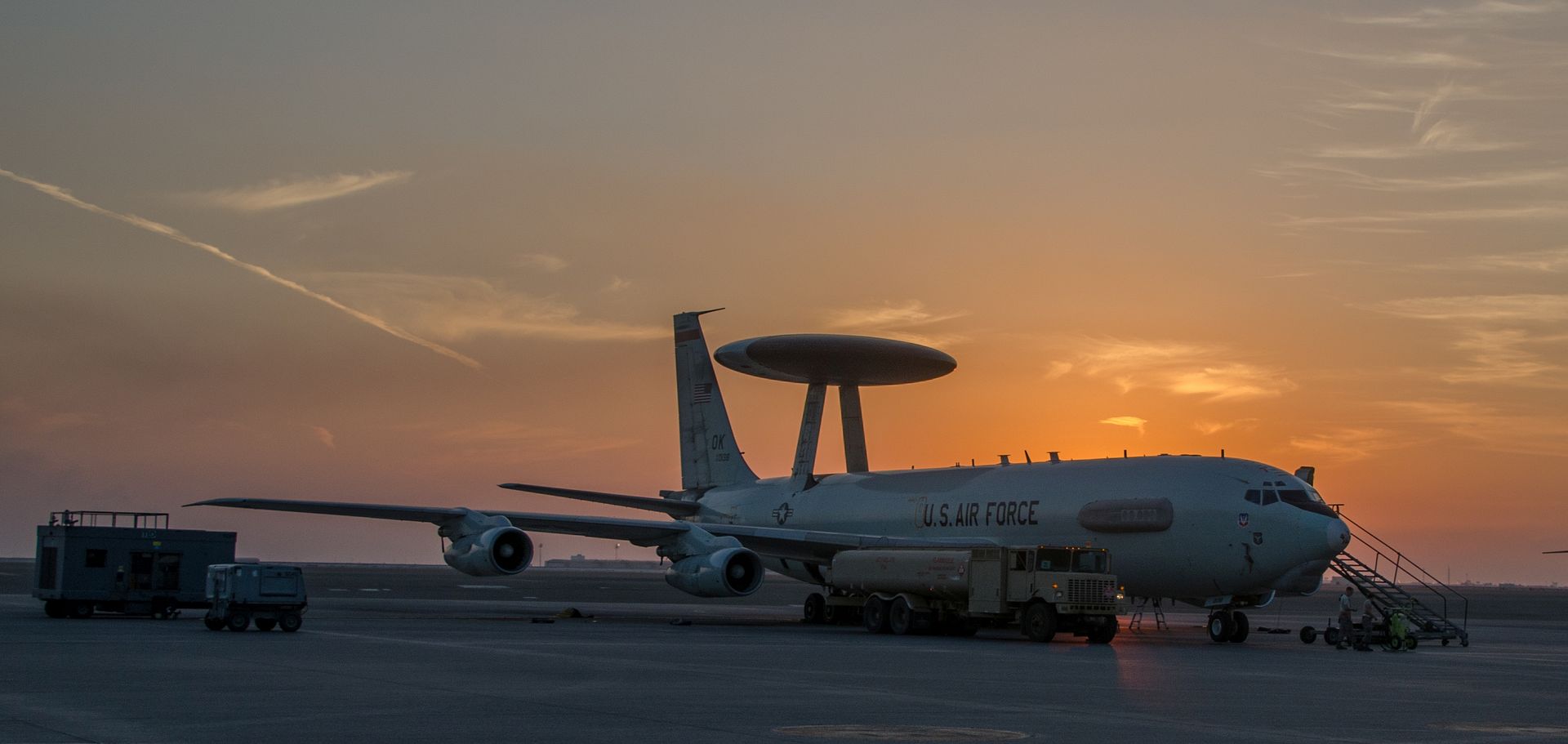
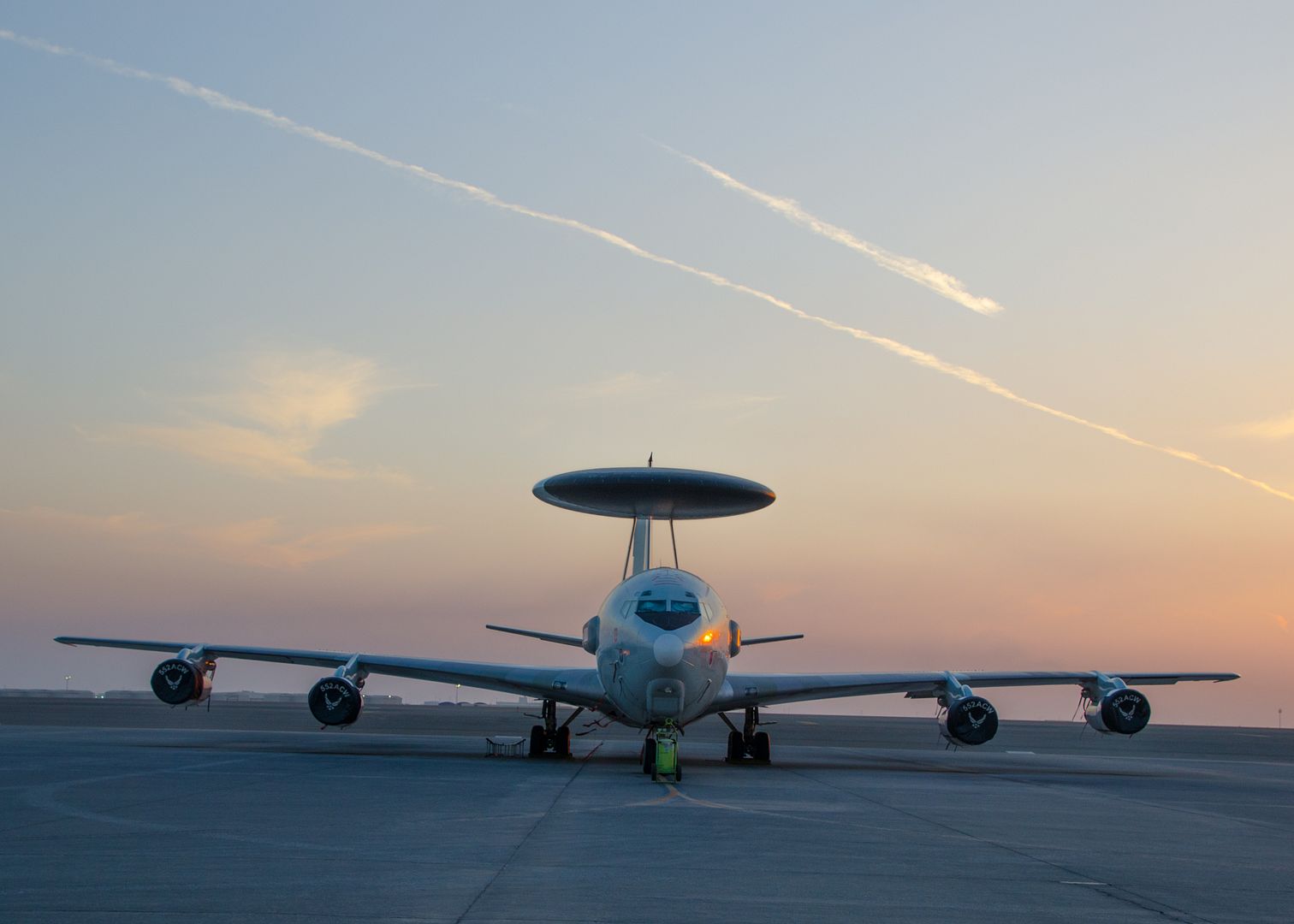
A U.S. C-5M Super Galaxy assigned to the 22nd Airlift Squadron takes off from Travis Air Force Base, Calif., Nov. 18, 2017. The C-5 was tasked to deliver U.S Navy undersea rescue capabilities to Argentina to aid in the search for the Argentina Navy submarine A.R.A San Juan. Air Mobility Command aircraft are delivering equipment and expertise to assist a partner nation. (U.S. Air Force photo by Master Sgt. Joey Swafford)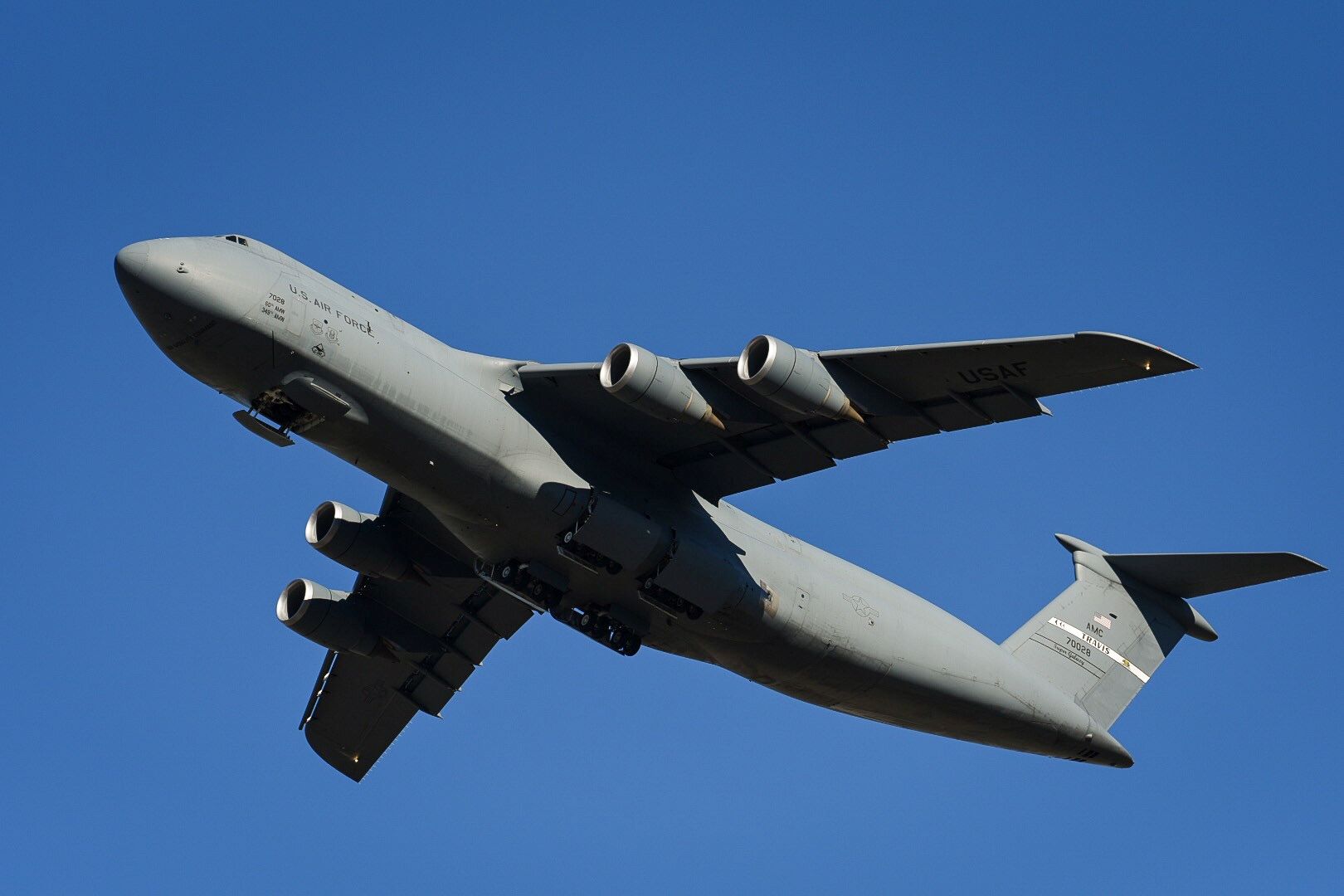
A 4th Fighter Wing F-15E Strike Eagle heritage paint scheme aircraft is positioned on the flightline in front of hangars, Nov. 8, 2017, at Seymour Johnson Air Force Base, North Carolina. The Strike Eagle was painted in honor of the 4th Fighter Wing?s 75th Anniversary and will be kept for a year. (U.S. Air Force photo's by Airman 1st Class Miranda A. Loera)
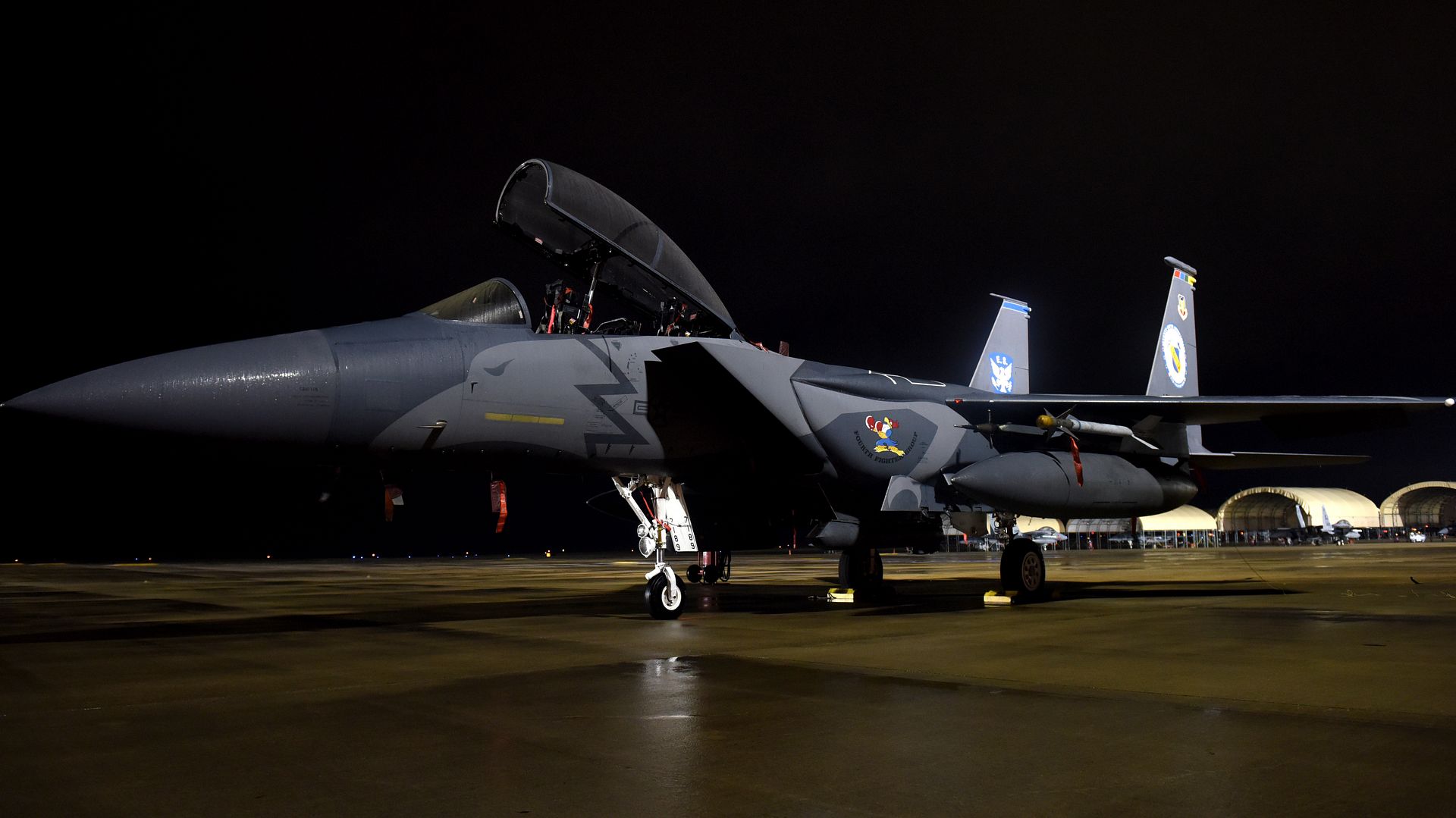
A U.S. Marine Corps MV-22B Osprey aircraft with Marine Medium Tiltrotor Squadron 162 (Reinforced), 26th Marine Expeditionary Unit (MEU), approaches for landing aboard the dock landing ship USS Oak Hill (LSD 51) in support of Combined Composite Training Unit Exercise aboard the dock landing ship USS Oak Hill (LSD) in the Atlantic Ocean, Nov. 16, 2017. COMPTUEX allows all elements of the Marine Air Ground Task Force to join and train in realistic scenarios so the MEU as a whole can meet its Predeployment Training Program objectives prior to an upcoming deployment at sea. (U.S. Marine Corps photo by Staff Sgt. Dengrier M. Baez)
After 40 years of service AP-3C Orion, tail number A9-751 has been delivered to the RAAF Museum for a well- earned rest.
Photo RAAF.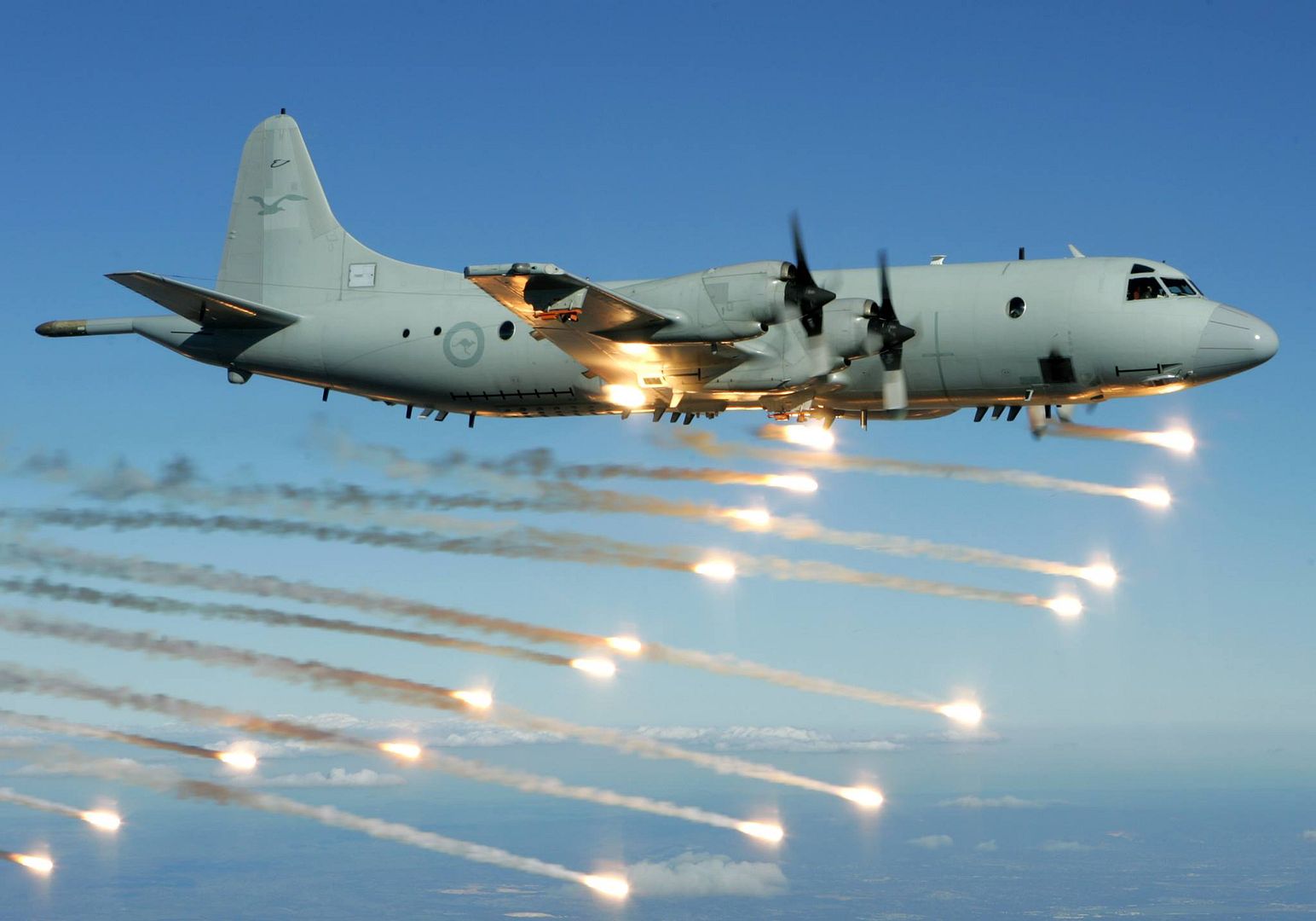
-
 Main AdminMOSCOW --- Russia?s newest A-100 aircraft of radar patrol and targeting made a maiden flight on Saturday, press service of the designer, Vega Radio Engineering Concern (a part of Russian Electronics of the Rostec Corporation), said.
Main AdminMOSCOW --- Russia?s newest A-100 aircraft of radar patrol and targeting made a maiden flight on Saturday, press service of the designer, Vega Radio Engineering Concern (a part of Russian Electronics of the Rostec Corporation), said.
"On November 18, 2017, the multifunctional aviation complex of radar patrol and targeting A-100 made a debut flight," the press service said.
According to the designer, during the first flight "were tested the aerodynamics characteristics, the aircraft?s avionics and elements of the radio-technical complex."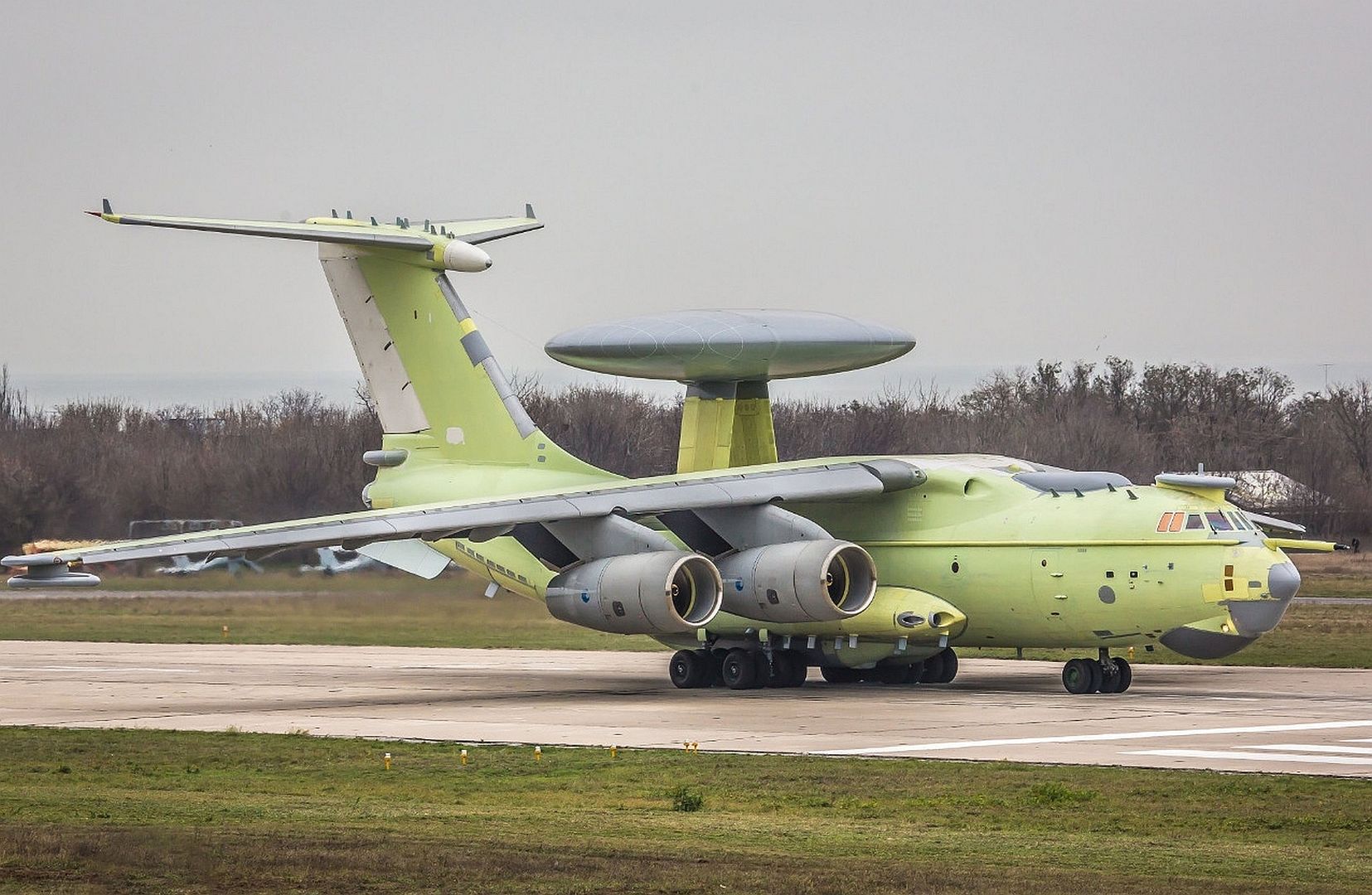
A-100 was created on the basis of Il-76MD-90A, on which the designers installed "a fairing with a unique antenna system and the latest special radar" to quickly build up the radar field at a predetermined operating direction. "Besides, the aviation complex may engage the air and other targets, as well as guide fighter and attack aircraft to hit air, ground and naval objectives," the designers said.
A-100 will replace A-50 and A-50U aircraft. TASS reported earlier, the new aircraft would be delivered to the Aerospace Force from 2020.
(Source: TASS; published Nov 18, 2017)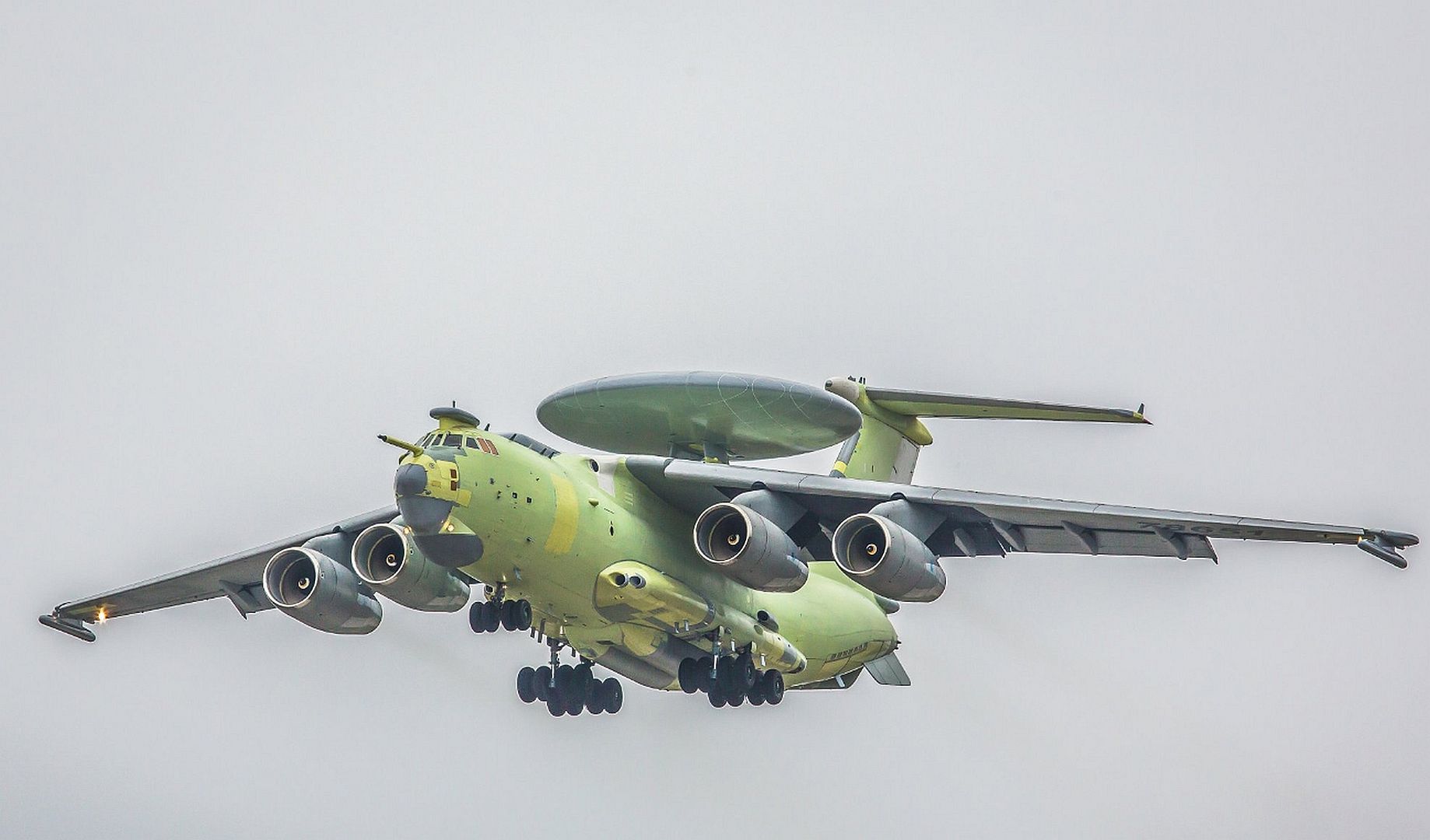
A U.S. Marine Corps AV-8B Harrier with Marine Medium Tiltrotor Squadron (VMM) 162 (REIN), 26th Marine Expeditionary Unit (MEU), takes off from the amphibious assault ship USS Iwo Jima (LHD 7) as part of Combined Composite Training Unit Exercise (COMPTUEX) in the Atlantic Ocean, Nov. 19, 2017. The exercise allows all elements of the Marine Air Ground Task Force (MAGTF) to join and train in realistic scenarios so the MEU as a whole can meet its Pre-Deployment Training Program objectives prior to their upcoming deployment at sea. (U.S. Marine Corps photo by Cpl. Jon Sosner)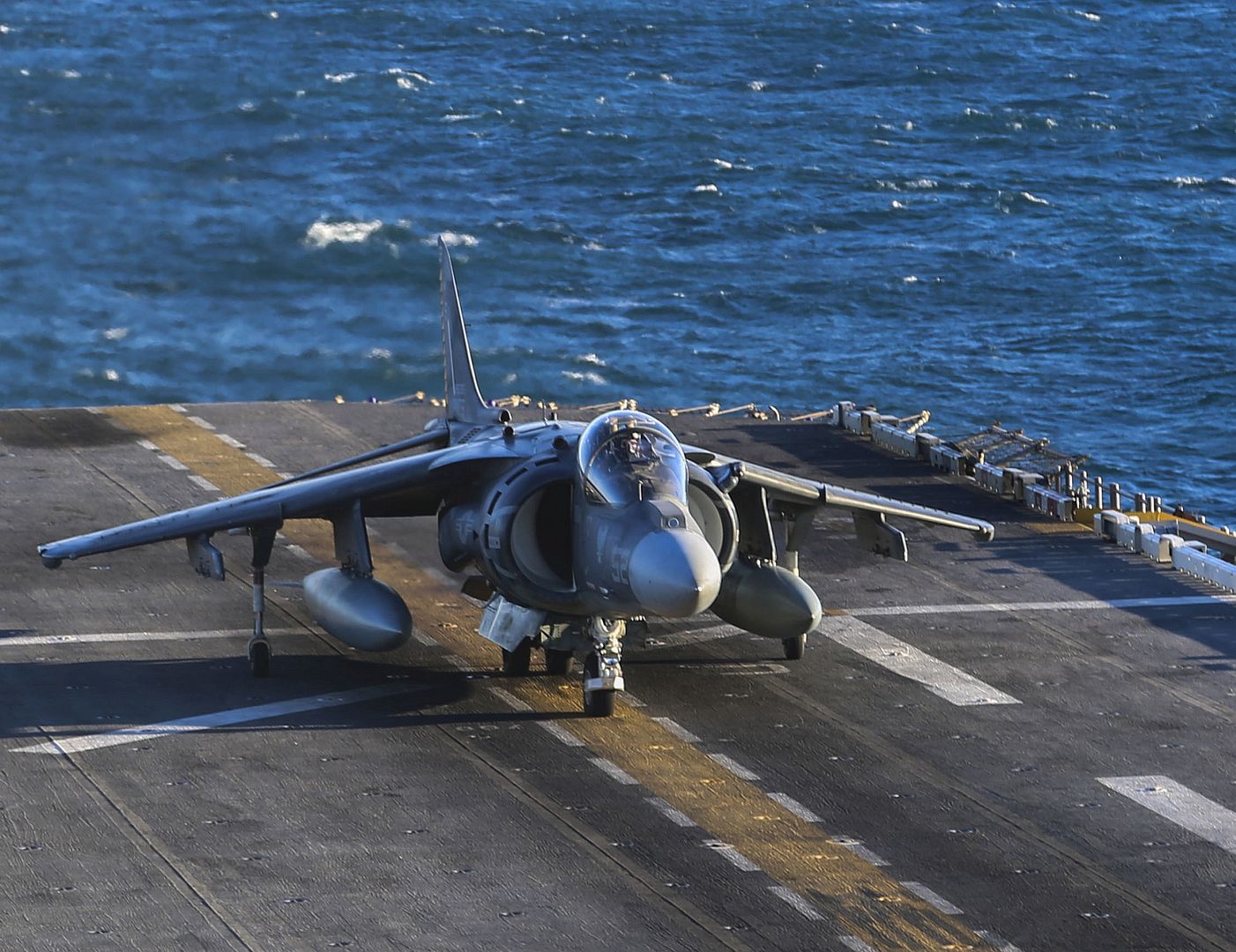
A KC-10 Extender from the 908th Expeditionary Air Refueling Squadron, Al Dhafra Air Base, United Arab Emirates is prepped to refuel F-22 Raptors from the 95th Expeditionary Fighter Squadron in support of a new offensive campaign in Afghanistan Nov. 19, 2017. Afghan National Defense and Security Forces (ANDSF) and United States Forces-Afghanistan (USFOR-A) launched a series of ongoing attacks to hit the Taliban where they are most vulnerable: their revenue streams. Together, Afghan and U.S. forces conducted combined operations to strike drug labs and command-and-control nodes in northern Helmand province. These types of strikes represent the highest level of trust and cooperation between ANDSF and USFOR-A. (U.S. Air Force Photo by Tech. Sgt. Anthony Nelson Jr.)(Released)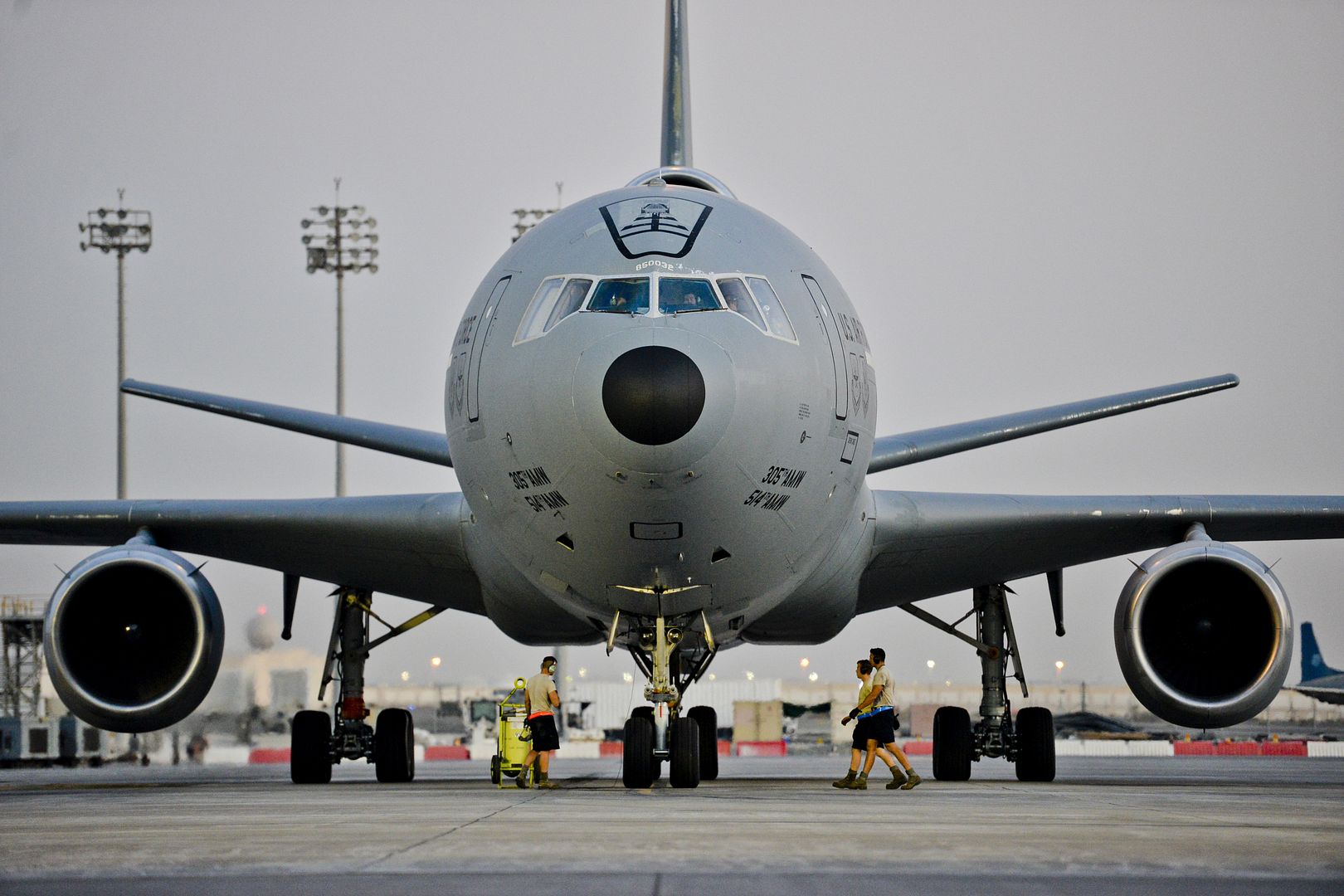
A KC-10 Extender from the 908th Expeditionary Air Refueling Squadron, Al Dhafra Air Base, United Arab Emirates, refuels an F-22 Raptor from the 95th Expeditionary Fighter Squadron in support of a new offensive campaign in Afghanistan Nov. 19, 2017. Afghan National Defense and Security Forces (ANDSF) and United States Forces-Afghanistan (USFOR-A) launched a series of ongoing attacks to hit the Taliban where they are most vulnerable: their revenue streams. Together, Afghan and U.S. forces conducted combined operations to strike drug labs and command-and-control nodes in northern Helmand province. These types of strikes represent the highest level of trust and cooperation between ANDSF and USFOR-A. (U.S. Air Force Photo's by Tech. Sgt. Gregory Brook)(Released)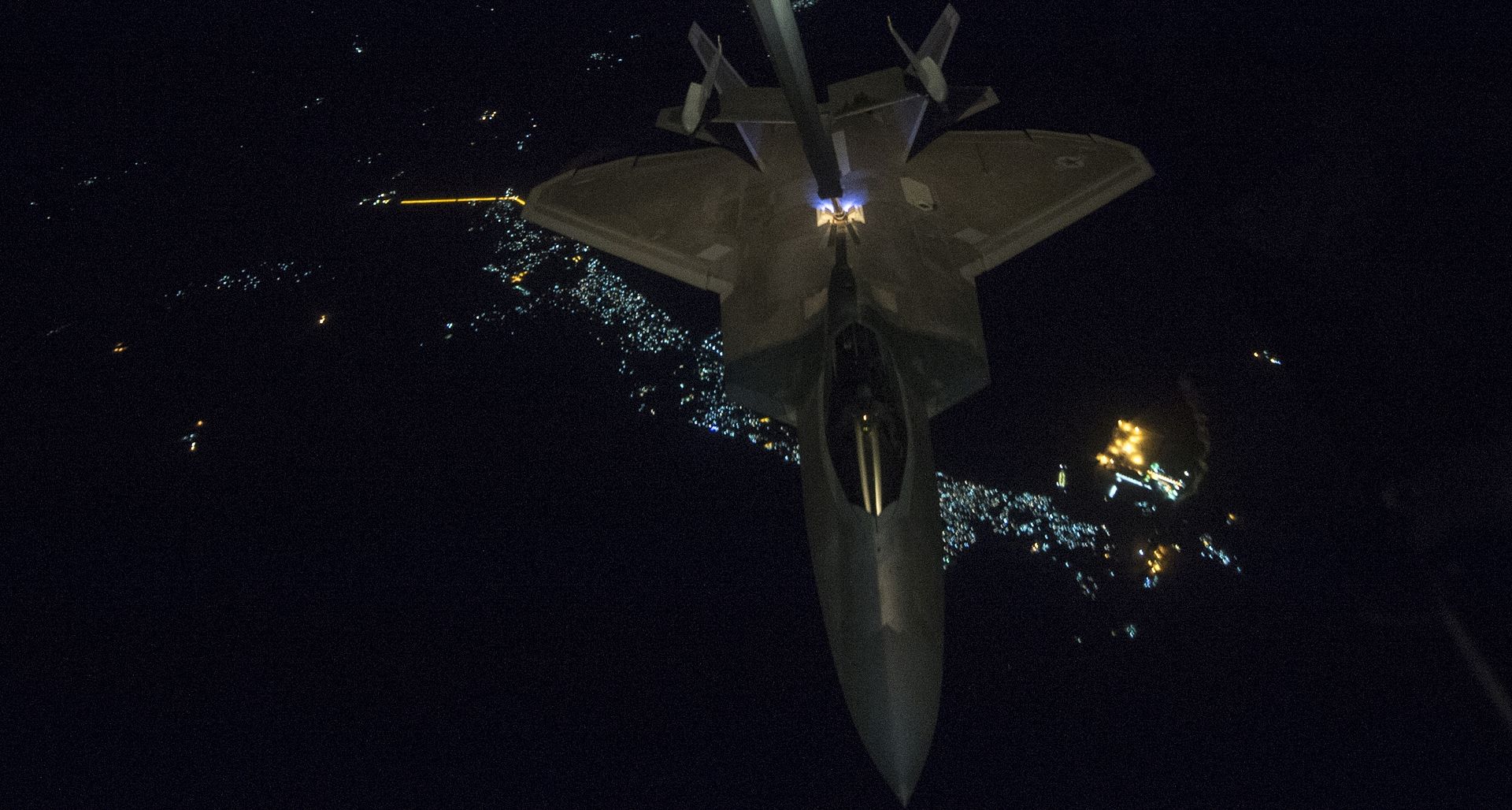
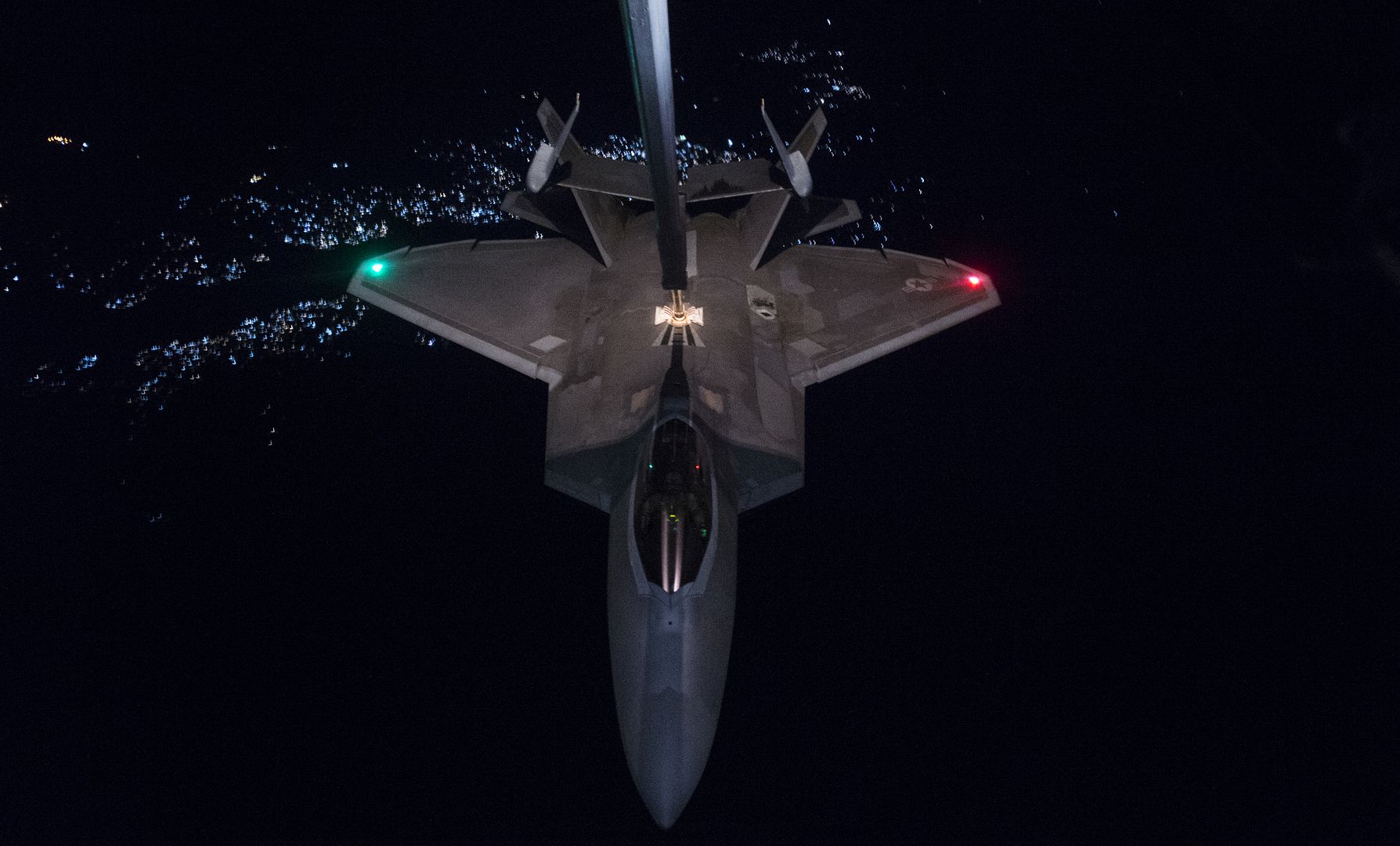
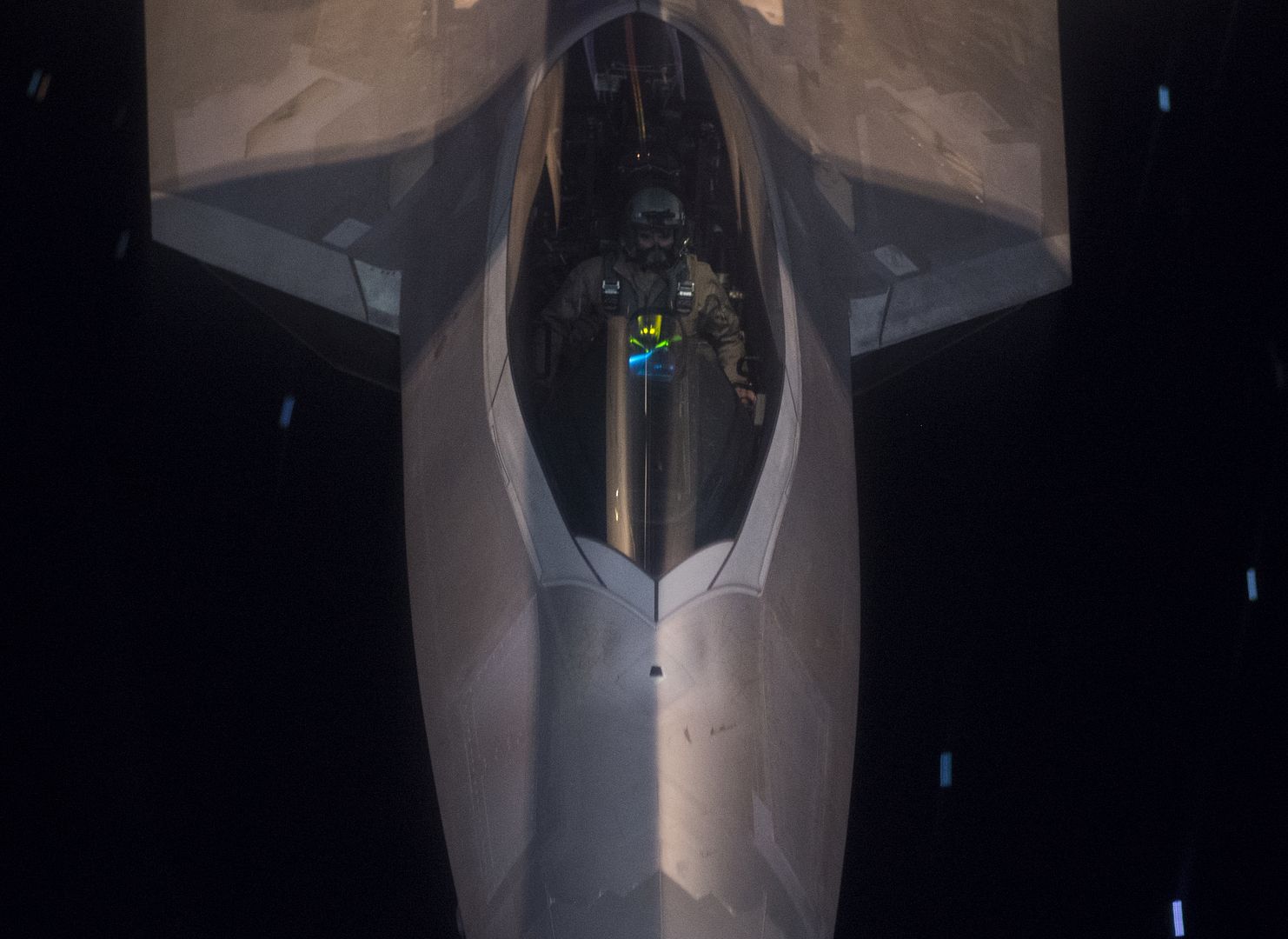
INDIAN OCEAN (Nov. 20, 2017) An F/A-18E Super Hornet, assigned to the Stingers of Strike Fighter Attack Squadron (VFA) 113, lands on the flight deck of the aircraft carrier USS Theodore Roosevelt (CVN 71). Theodore Roosevelt is deployed in support of maritime security operations and theater security cooperation efforts. (U.S. Navy photo by Mass Communication Specialist 3rd Class Spencer Roberts/Released)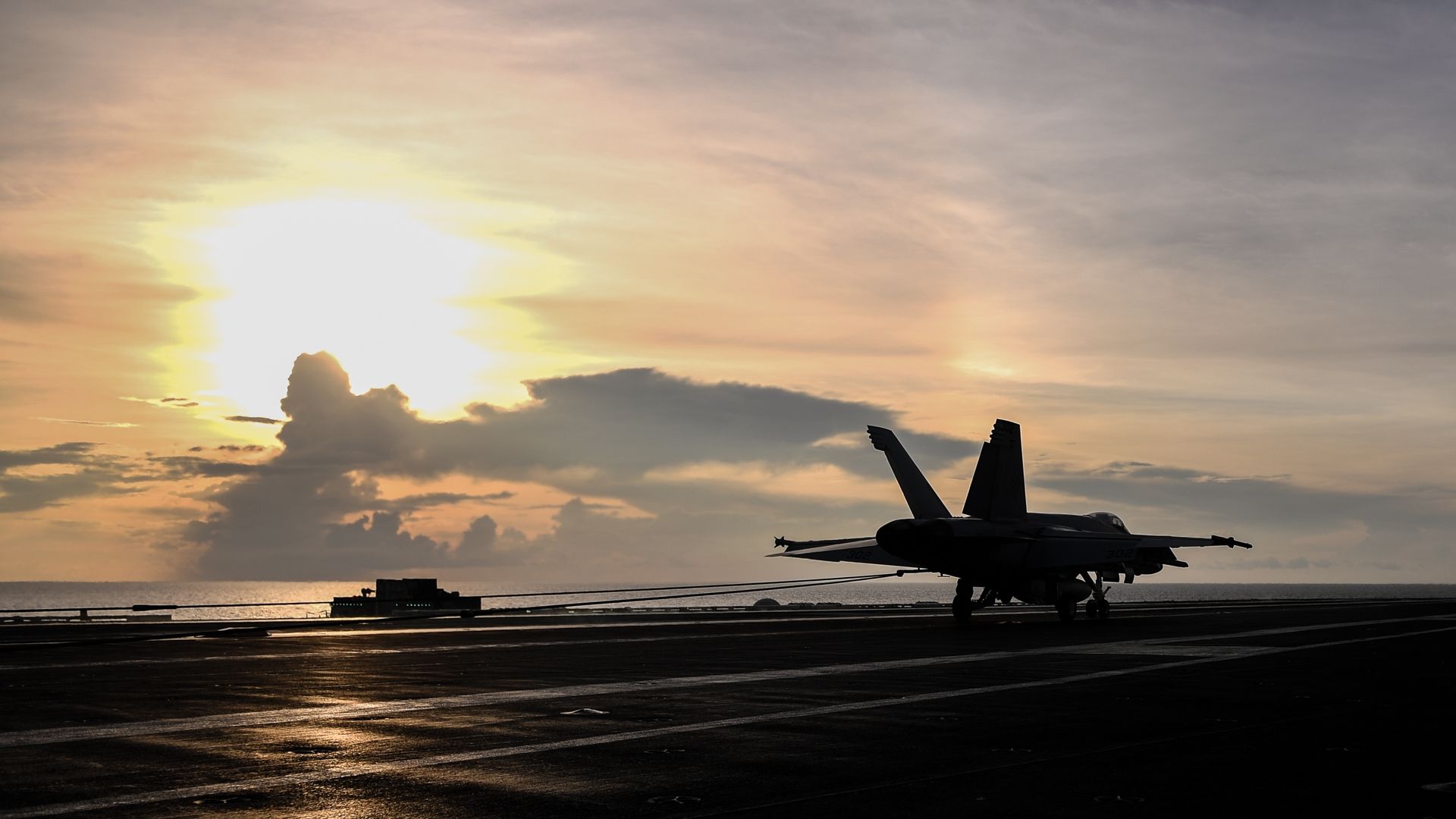
SEATTLE, Nov. 19, 2017 /PRNewswire/ -- Boeing (NYSE: BA) and Avolon, the international aircraft leasing company, today finalized an order for 75 737 MAX airplanes. The confirmed order is for 55 MAX 8s and 20 MAX 10s, with options for 20 additional MAX 8s.
The agreement, announced as a memorandum of understanding at the 2017 Paris Air Show, is valued at nearly $11 billion at list prices including the 75 firm and 20 option aircraft.
Launched at the 2017 Paris Air Show, the MAX 10 will have the lowest seat-mile cost of any single-aisle airplane. The new airplanes will bolster Avolon's airplane portfolio to meet growing customer demand in the narrow-body market segment.
"Today's order for Boeing's newest 737 MAX airplanes will strengthen Avolon's position as a leading lessor in the global commercial aviation market," said Avolon CEO, D?mhnal Slattery. "This is the largest single order that we have placed with Boeing to date and underscores the scale of our ambition and the strength of our business. We have experienced strong interest in our initial MAX orders and this incremental order reflects this demand. With over 140 MAX aircraft now in our owned and committed fleet, we are confident that the superior economics and solid reliability of the 737 MAX family of airplanes will continue to allow our customers to grow their businesses profitably for many years to come."
Headquartered in Dublin, Ireland, Avolon is one of the world's leading aircraft leasing firms, with an owned, managed and committed fleet of 915 aircraft as of September 30, 2017. Avolon also has the youngest owned fleet amongst the top three lessors and an order book of exclusively new technology aircraft.
"Today's order solidifies Avolon's commitment to providing their customers with the most efficient, technologically advanced airplane on the market," said Boeing Commercial Airplanes President and CEO Kevin McAllister. "We are honored that the 737 MAX family of airplanes will become a key part of Avolon's world-class fleet as they look to leverage the surging demand for narrow-body airplanes in markets around the world."
The 737 MAX is the fastest-selling airplane in Boeing history, having surpassed 4,000 total orders from 92 customers. The MAX family incorporates the latest technology CFM International LEAP-1B engines, Advanced Technology winglets and other improvements to deliver the highest efficiency, reliability and passenger comfort in the single-aisle market.
About Avolon
Headquartered in Ireland, with offices in the United States, Dubai, Singapore, Hong Kong and Shanghai, Avolon provides aircraft leasing and lease management services. Avolon is a wholly-owned, indirect subsidiary of Bohai Capital Holding Co., Ltd., a Chinese public company listed on the Shenzhen Stock Exchange (SLE: 000415). Avolon is the world's third largest aircraft leasing business with a pro-forma owned, managed and committed fleet, as of 30 September, 2017 of 915 aircraft.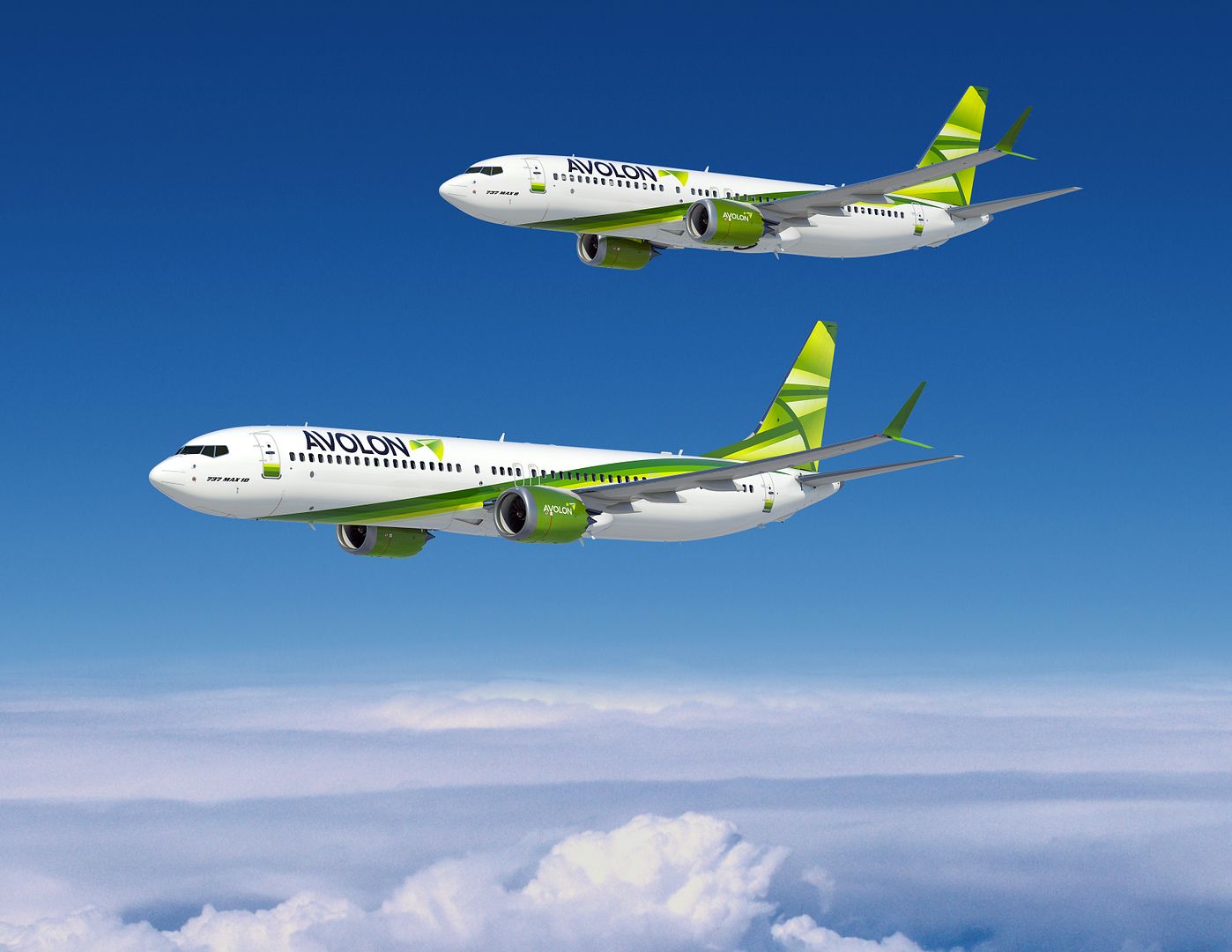
Leonardo is pleased to announce that the first of 16 AW101 all-weather search and rescue helicopters has been delivered to the Norwegian Ministry of Justice & Public Security. The aircraft departed Leonardo?s Yeovil facility on November 17th for Sola Air Base in southern Norway where the aircraft will enter a period of Operational Test & Evaluation (OT&E) before entering service with the Royal Norwegian Air Force in 2018. Aircraft deliveries will continue through to 2020 with SAR operations being established with the aircraft deployed across each of the six main operating bases.
Bj?rn Ivar Aarseth NAWSARH Project Manager, Ministry of Justice & Public Security said: ?The delivery of the first aircraft marks a major milestone for the Norwegian All-Weather Search and Rescue Helicopter programme and everyone is delighted to see the first AW101 in Norway. I would like to congratulate my team in the Ministry of Justice, key contributors within the Norwegian Defence sector, Leonardo and all other industry partners on achieving this milestone.?
Jon Clark, Leonardo?s Programme Manager said: ?The AW101 we have developed for Norway is undoubtedly the world?s most capable SAR helicopter and it is with great pride that we have delivered the first aircraft that will serve the people of Norway for decades to come. This contract is very much a long term partnership, consisting of industry, the Ministry of Justice & Public Security, the Royal Norwegian Air Force and the Norwegian Defence Materiel Agency, which has a common goal to deliver a SAR service second to none - we are all looking forward to the aircraft entering operational service in 2018.?
The AW101 benefits from three-engine safety, a full ice protection system for flight in known icing conditions, long range and endurance, a proven 30 minute ?run dry? gearbox as well as multiple redundancy features in the avionic and mission systems. The large cabin doors and rear ramp provide easy access for personnel, survivors and equipment into the 27 m3 cabin which has stand-up head room throughout.
The aircraft is equipped with an advanced SAR equipment package including a multi-panel Osprey AESA surveillance radar system from Leonardo that provides 360? coverage, 4-axis digital Automatic Flight Control System (AFCS), two rescue hoists, searchlight, electro optical device and a fully integrated avionics and mission system. Other systems and equipment include a mobile telephone detection system, obstacle proximity warning system, weather radar, complete medical station and mission console.
Leonardo is providing initial support and training services, including spares at each of the operating bases and has recently completed the aircrew training for the initial group of aircrew. It will then provide performance based logistic support to deliver approximately 90,000 flying hours across the fleet of 16 helicopters over the initial 15 year period.
Leonardo has partnered with Norwegian companies AIM Aviation to provide maintenance services at the Royal Norwegian Air Force?s six operating bases and with Kongsberg Defence Systems to provide helicopter transmission repair and overhaul services in Norway.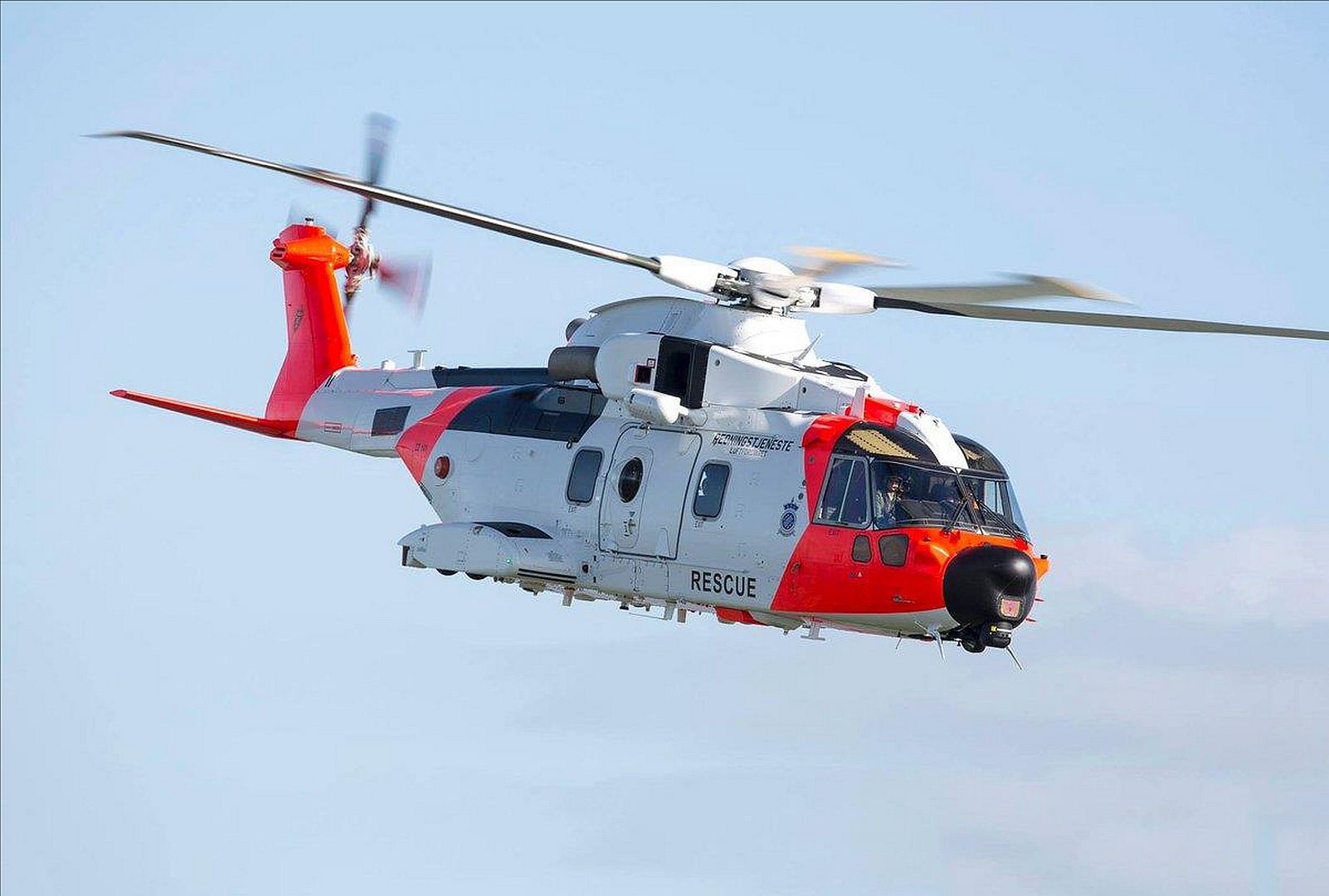
-
 Main AdminA U.S. Air Force C-17 Globemaster III taxis before taking off after delivering U.S Navy rescue equipment to Comodoro Rivadavia, Argentina, Nov. 20, 2017. The equipment will be used in Argentina to aid in the search for the Argentina Navy submarine A.R.A San Juan. Air Mobility Command aircraft are delivering equipment and expertise to assist a partner nation. (U.S. Air Force photo's by Staff Sgt. Nicole Leidholm)
Main AdminA U.S. Air Force C-17 Globemaster III taxis before taking off after delivering U.S Navy rescue equipment to Comodoro Rivadavia, Argentina, Nov. 20, 2017. The equipment will be used in Argentina to aid in the search for the Argentina Navy submarine A.R.A San Juan. Air Mobility Command aircraft are delivering equipment and expertise to assist a partner nation. (U.S. Air Force photo's by Staff Sgt. Nicole Leidholm)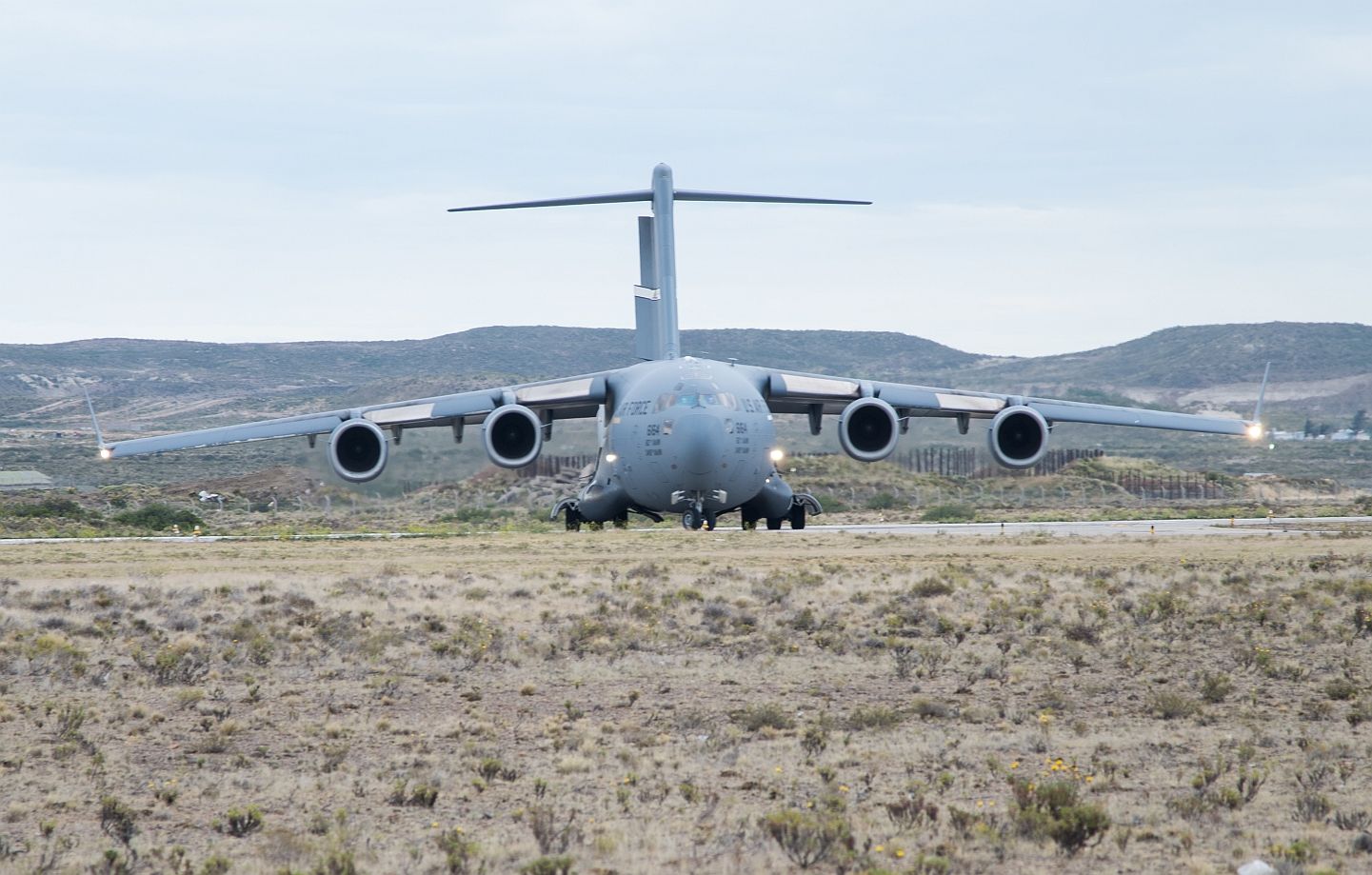
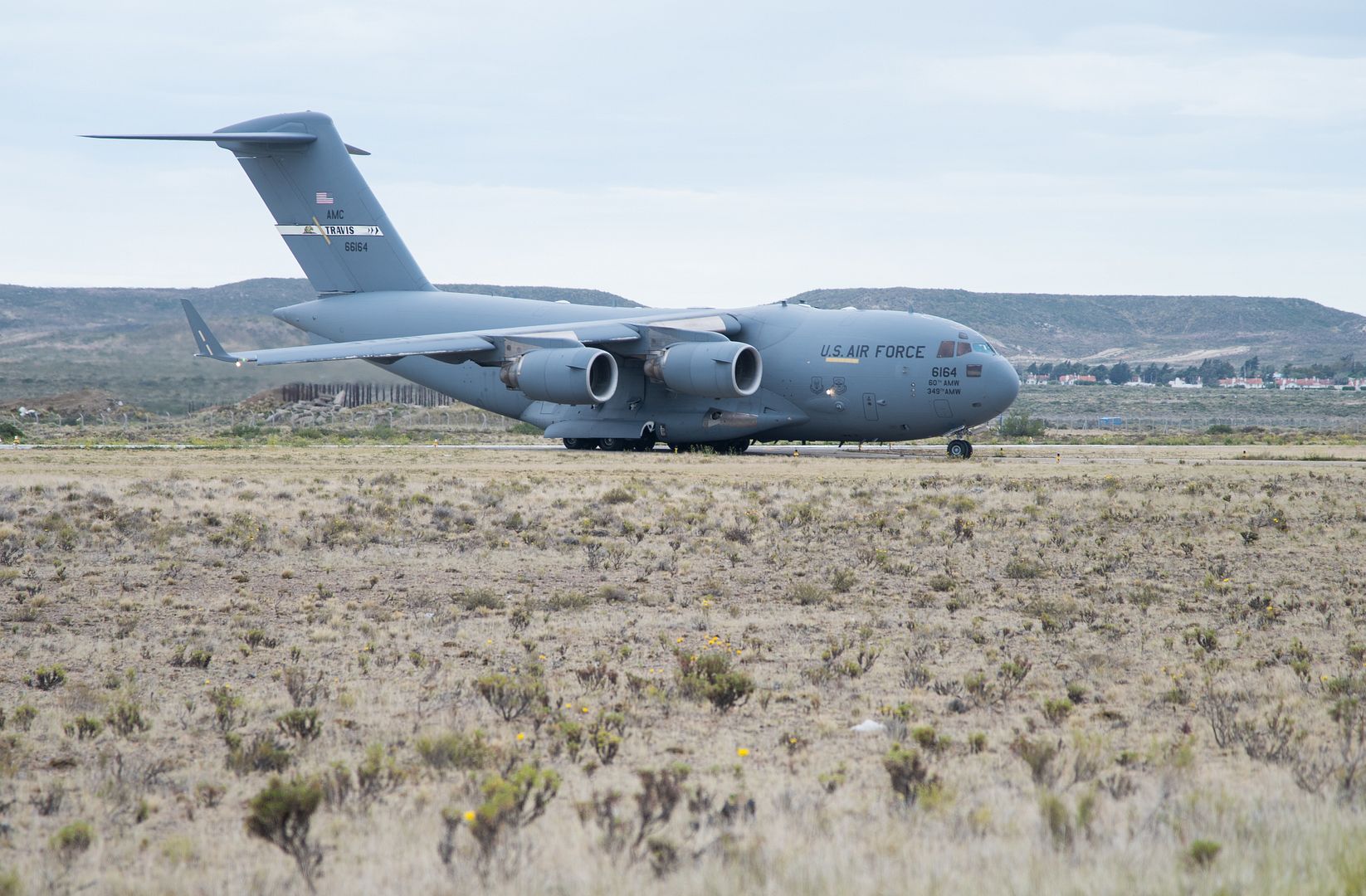
INDIAN OCEAN (Nov. 20, 2017) An EA-18G Growler, assigned to the Cougars of Electronic Attack Squadron (VAQ) 139, takes off from the flight deck of the aircraft carrier USS Theodore Roosevelt (CVN 71). Theodore Roosevelt is deployed in support of maritime security operations and theater security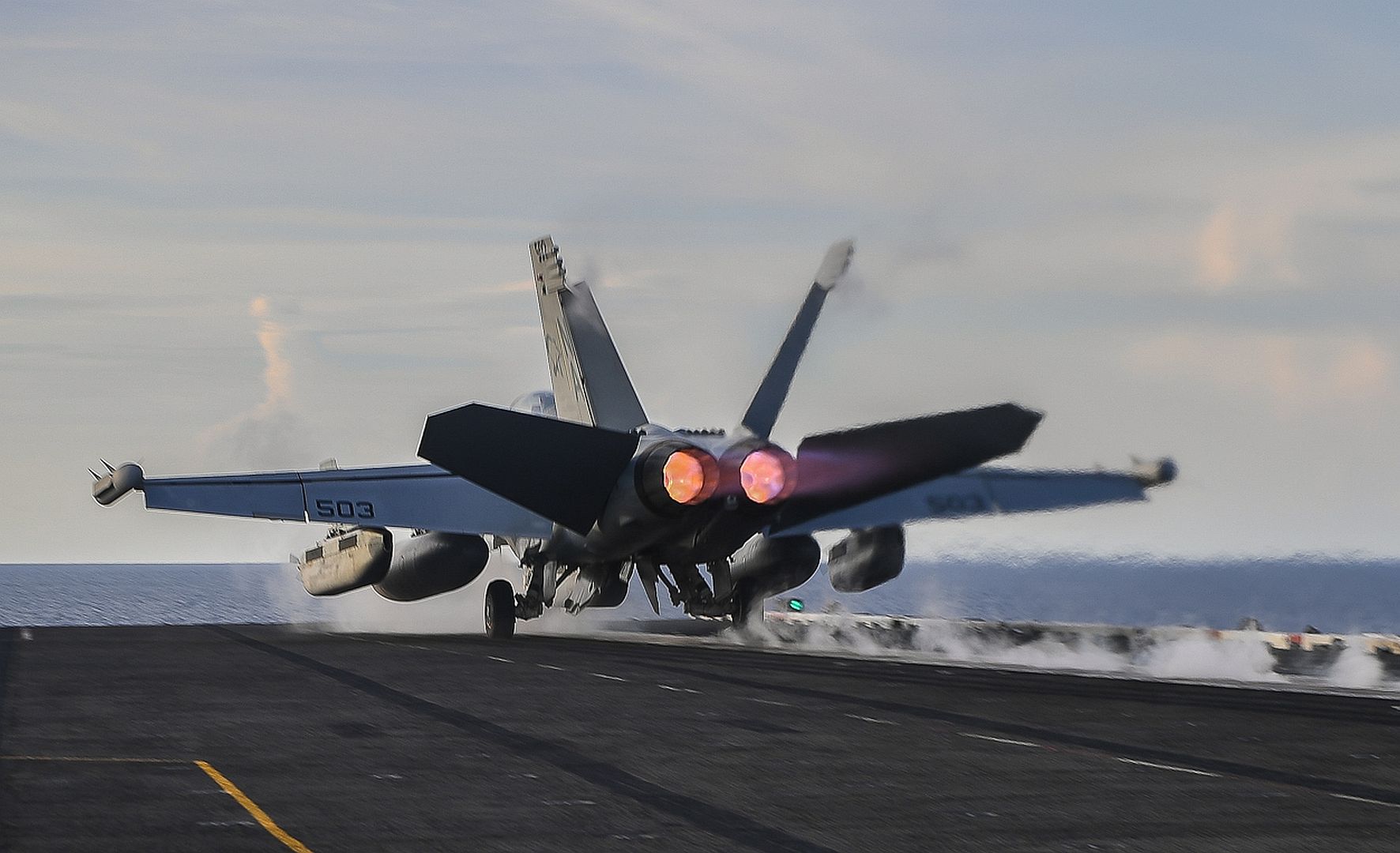
INDIAN OCEAN (Nov. 20, 2017) An F/A-18F Super Hornet, assigned to the Mighty Shrikes of Strike Fighter Attack Squadron (VFA) 94, lands on the flight deck of the aircraft carrier USS Theodore Roosevelt (CVN 71). Theodore Roosevelt is deployed in support of maritime security operations and theater security cooperation efforts. (U.S. Navy photo by Mass Communication Specialist 3rd Class Spencer Roberts/Released)
A U.S. Marine Corps CH-53E Super Stallion with Marine Medium Tiltrotor Squadron (VMM) 162 (REIN), 26th Marine Expeditionary Unit (MEU), lands on the amphibious assault ship USS Iwo Jima (LHD 7) as part of Combined Composite Training Unit Exercise (COMPTUEX) in the Atlantic Ocean, Nov. 20, 2017. The exercise integrates all elements of the Marine Air Ground Task Force (MAGTF) to participate and train in realistic scenarios so the MEU as a whole can meet its Pre-Deployment Training Program objectives prior to their upcoming deployment at sea. (U.S. Marine Corps photo by Cpl. Jon Sosner)
A U.S. Marine Corps MV-22B Osprey with Marine Medium Tiltrotor Squadron (VMM) 162 (REIN), 26th Marine Expeditionary Unit (MEU), takes off from the amphibious assault ship USS Iwo Jima (LHD 7) as part of Combined Composite Training Unit Exercise (COMPTUEX) in the Atlantic Ocean, Nov. 20, 2017. The exercise integrates all elements of the Marine Air Ground Task Force (MAGTF) to participate and train in realistic scenarios so the MEU as a whole can meet its Pre-Deployment Training Program objectives prior to their upcoming deployment at sea. (U.S. Marine Corps photo by Cpl. Jon Sosner)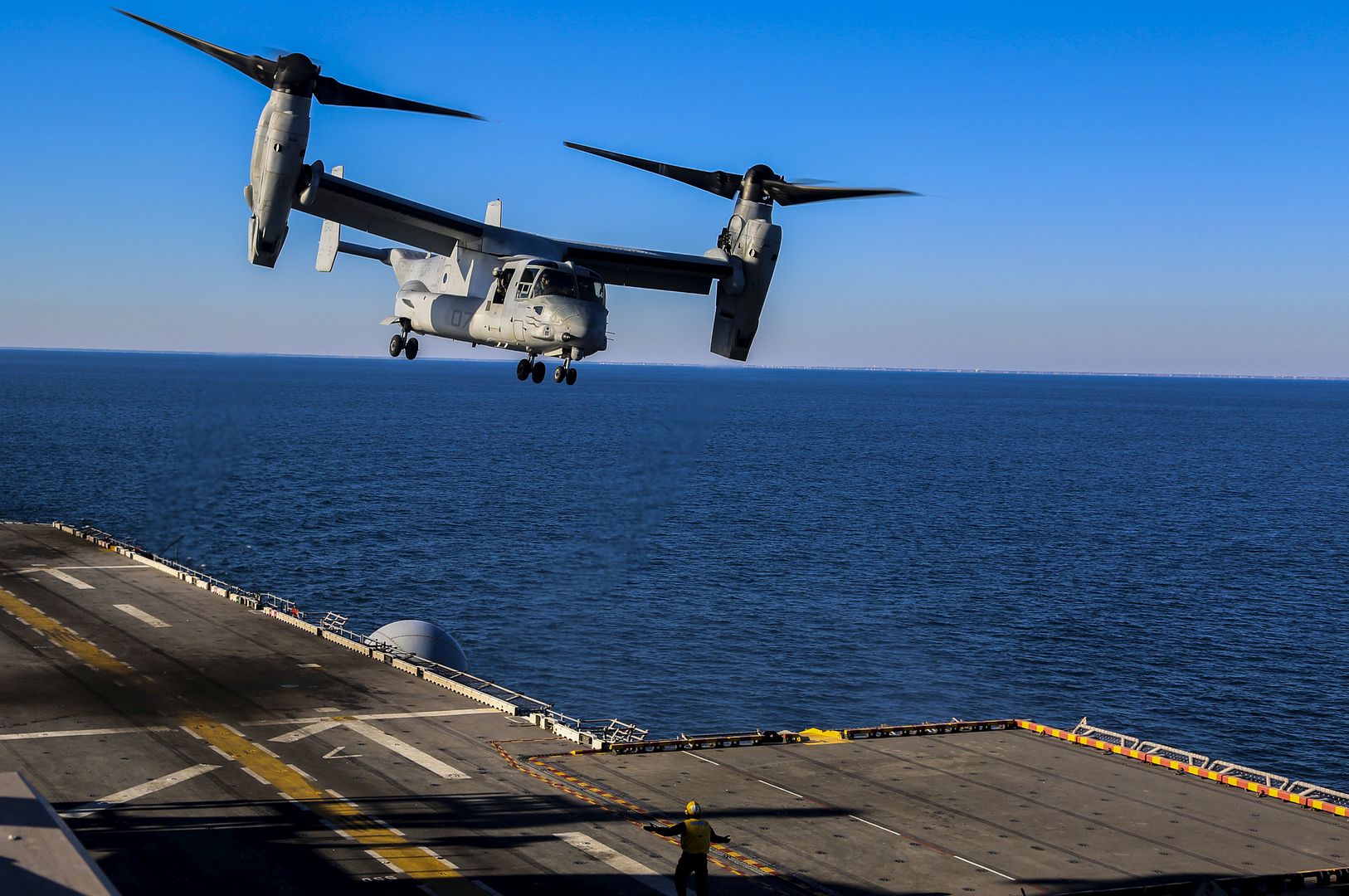
November 21
Following an intensive flight test campaign performed in less than a year, the A350-1000 has received Type Certification from the European Aviation Safety Agency (EASA) and the Federal Aviation Administration (FAA). The certified aircraft is powered by Rolls-Royce Trent XWB-97 engines.
The EASA A350-1000 Type Certification document was signed by EASA?s Certification Director, Tr?vor Woods, and the FAA A350-1000 Type Certification document was signed by FAA?s International Section Manager, Bob Breneman. Both certificates were handed over to Airbus Executive Vice President Engineering, Charles Champion.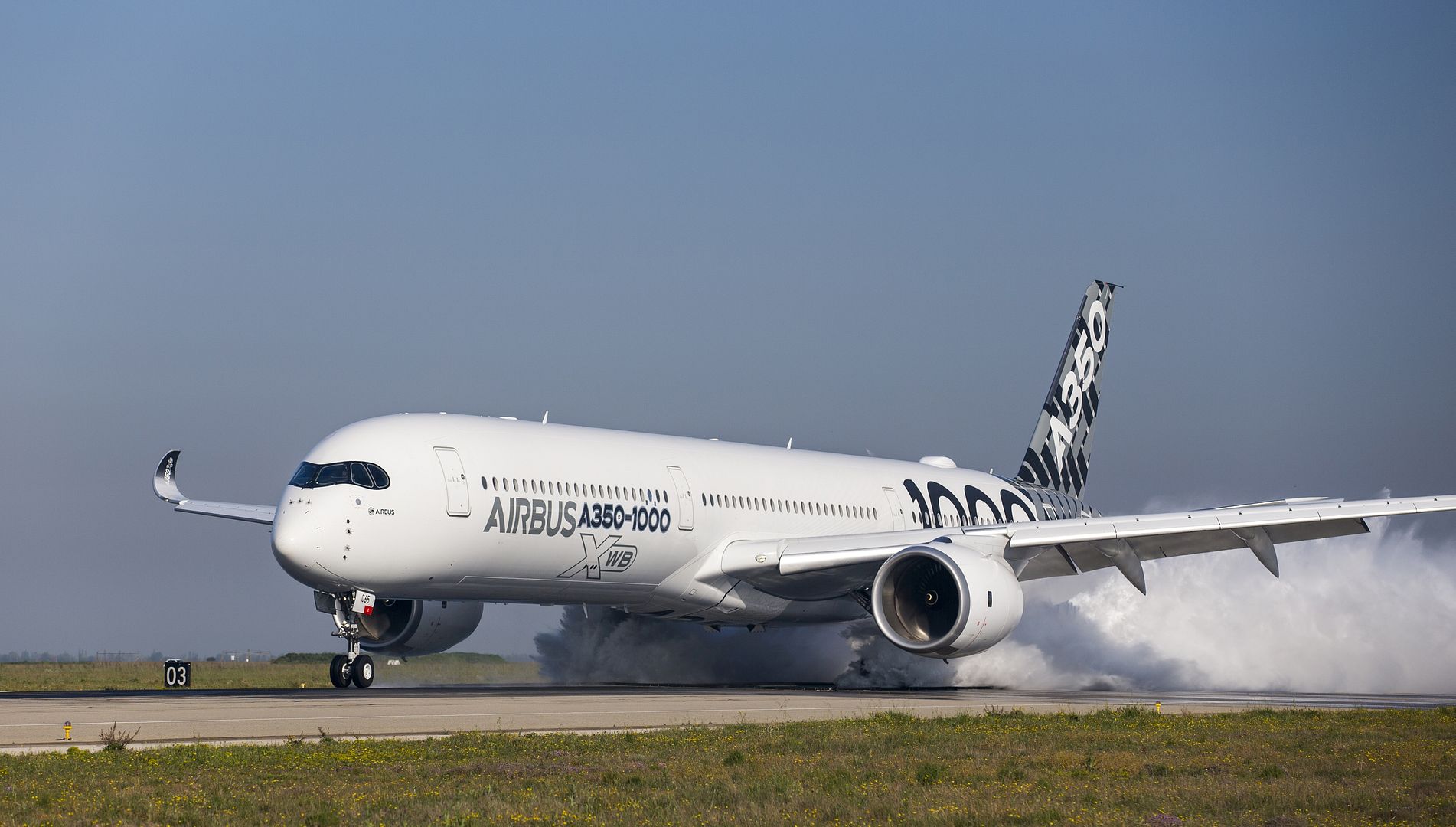
?Receiving the A350-1000 Type Certification from EASA and FAA less than one year after its first flight is an incredible achievement for Airbus and for all our partners who have been instrumental in building and testing this superb widebody aircraft,? said Fabrice Br?gier, Airbus COO and President Commercial Aircraft. ?The A350-1000 benefits from the maturity of its successful brother, the A350-900, which has translated into excellent right-on-time performance. We now look forward to deliver the first aircraft to Qatar Airways by the end of the year.?
The Type certification is a requirement for the aircraft to enter commercial service. This milestone comes after an intensive flight test trials that have taken its airframe and systems beyond their design limits to ensure the aircraft successfully meets all airworthiness criteria. The three A350-1000 flight test aircraft powered by Rolls-Royce engines successfully accumulated over 1,600 flight hours. Of these 150 flight test hours were completed with the same aircraft in an airline like operational environment to demonstrate its readiness for entry into service.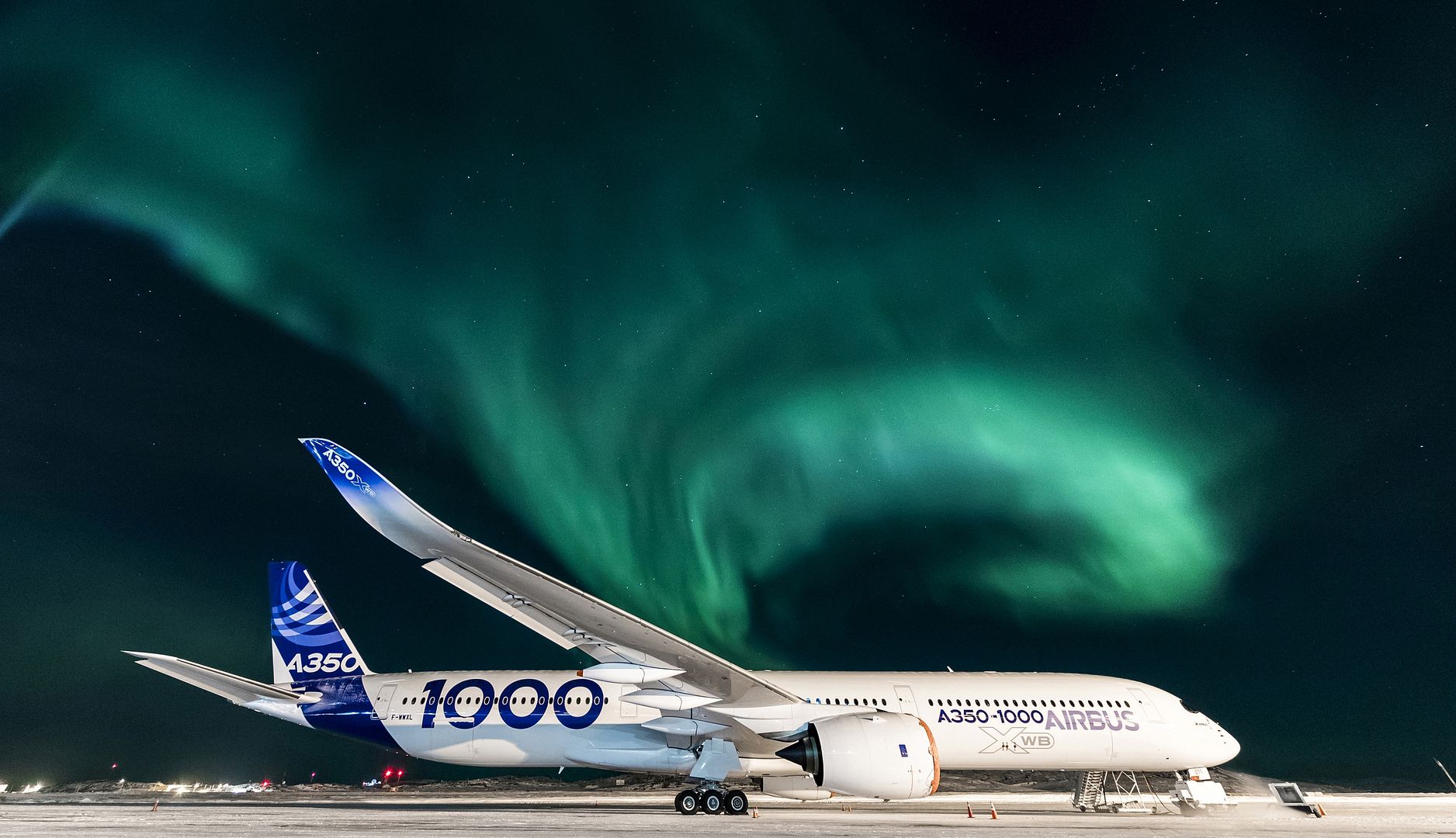
The A350-1000 is the latest member of Airbus? leading widebody family, showing high level of commonality with the A350-900 with 95% common systems part numbers and Same Type Rating. As well as having a longer fuselage to accommodate 40 more passengers than the A350-900 (in a typical 3-class configuration), the A350-1000 also features a modified wing trailing-edge, new six-wheel main landing gears and more powerful Rolls-Royce Trent XWB-97 engines. Along with the A350-900, the A350-1000 is shaping the future of air travel by offering unprecedented levels of efficiency and unrivalled comfort in its ?Airspace? cabin. With its additional capacity the A350-1000 is perfectly tailored for some of the busiest long-haul routes. To date 11 customers from five continents have ordered a total of 169 A350-1000s.
-
 Main AdminA New Jersey National Guard KC-135R Stratotanker from the 108th Wing sits on the flightline on Joint Base McGuire-Dix-Lakehurst, N.J, Nov. 21, 2017. This photo was captured with a 30 second exposure. (U.S. Air National Guard photo by Master Sgt. Matt Hecht)
Main AdminA New Jersey National Guard KC-135R Stratotanker from the 108th Wing sits on the flightline on Joint Base McGuire-Dix-Lakehurst, N.J, Nov. 21, 2017. This photo was captured with a 30 second exposure. (U.S. Air National Guard photo by Master Sgt. Matt Hecht)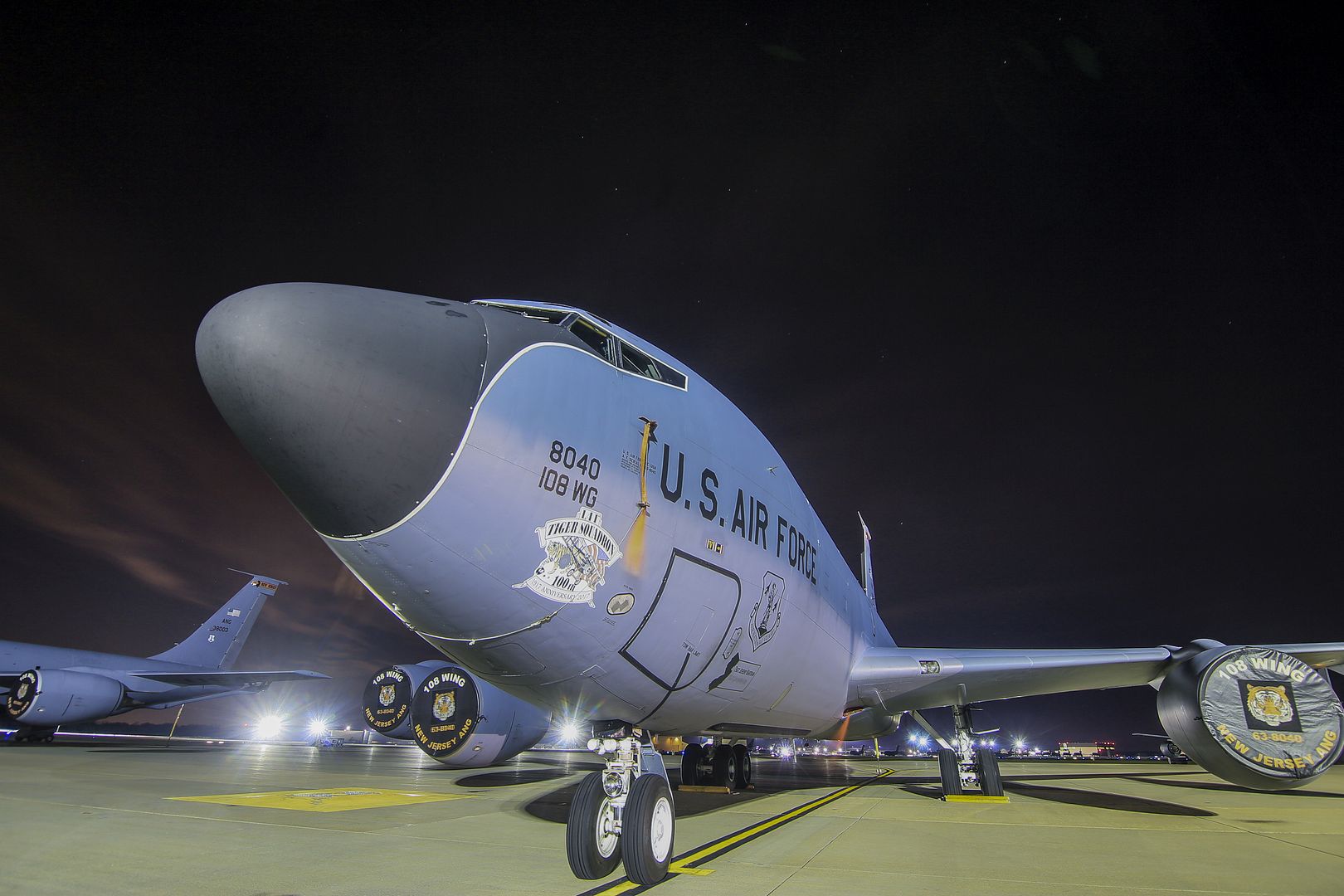
A Chinook helicopter from the 2-227th Aviation Regiment, 1st Air Cavalry Brigade out of Fort Hood Texas sit on the flight line at Katterbach Army Airfield in Ansbach, Bavaria, Germany, during sunset Nov. 21, 2017. The 2-227th Aviation Regiment, 1st Air Cavalry Brigade is on a nine-month rotation in support of Atlantic Resolve. Atlantic Resolve is a demonstration of continued U.S. commitment to collective security through a series of actions designed to reassure NATO allies and partners of America's dedication to enduring peace and stability in the region. (U.S. Army photo by Charles Rosemond)
Seoul, Airbus Helicopters has been awarded a contract from South Korea's National 119 Rescue Headquarters for the purchase of two additional H225 helicopters.
The National 119 Rescue Headquarters currently operates an all-Airbus helicopter fleet comprising two AS365 N2 and two H225. This new purchase will bring the fleet of the country's primary provider of firefighting and rescue services to six helicopters by end 2019.
The agency will be using these two multirole H225 helicopters for search and rescue missions, with the flexibility to reconfigure them to accommodate fire-fighting and emergency medical services equipment onboard the aircraft.
"The National 119 Rescue Headquarters has been operating Airbus helicopters for over 20 years and we are happy to see how our helicopters have continued to play a vital role in the agency's mandate to protect and save lives", said Marie-Agnes Veve, Head of North Asia of Airbus Helicopters. "The addition of the two H225 to the agency?s fleet illustrates our customer?s confidence in our products and their performance. Given its versatility and endurance in all-weather condition, we know the H225 will continue to be a capable workhorse for the agency?s missions."
The H225, the latest member of Airbus Helicopters' Super Puma family, is an 11-ton category twin-turbine multirole utility rotorcraft which accommodates up to 24 passengers. Equipped with state-of-the-art electronic instruments and autopilot system, the H225 offers outstanding endurance and fast cruise speed, and may be fitted with various equipment to suit any role.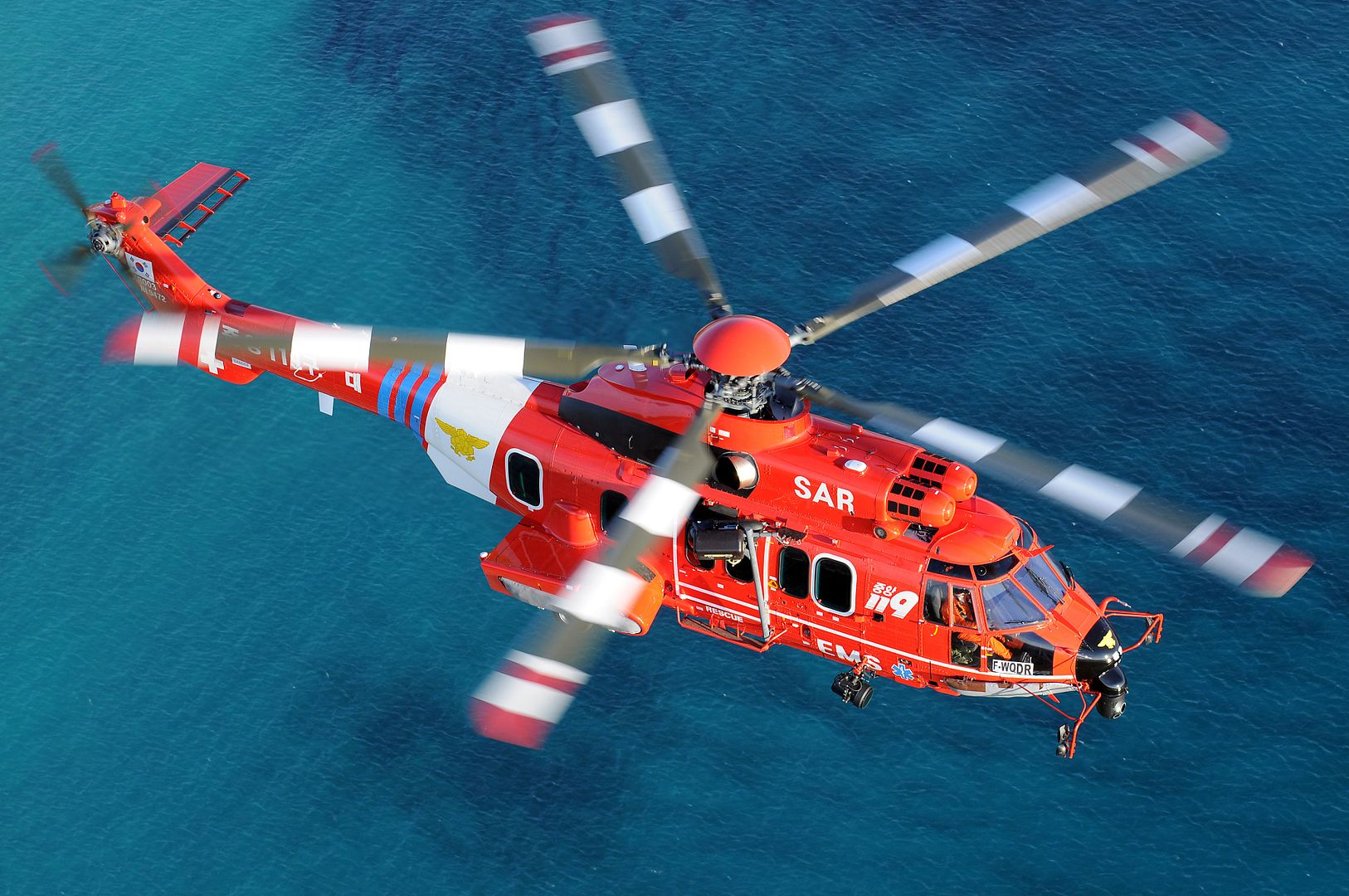
Jacksonville, FL, November 20th, 2017 - The new Embraer KC-390 multi-mission military transport and tanker jet will start a series of flight trials in the United States as part of its flight test campaign for certification. The aircraft left Brazil last Saturday and today arrived at Embraer?s facility in Jacksonville, Florida.
For the next two to three weeks, the aircraft will be performing tests in the avionics systems, measurement of external noise and operations with cross wind.
?The KC-390 sets new standards in the market and the flight test campaign is progressing extremely well matching the aircraft design goals,? said Jackson Schneider, president and CEO of Embraer Defense & Security. ?We are very satisfied with the maturity that this product has already reached and fully confident that its certification will be achieved as scheduled.?
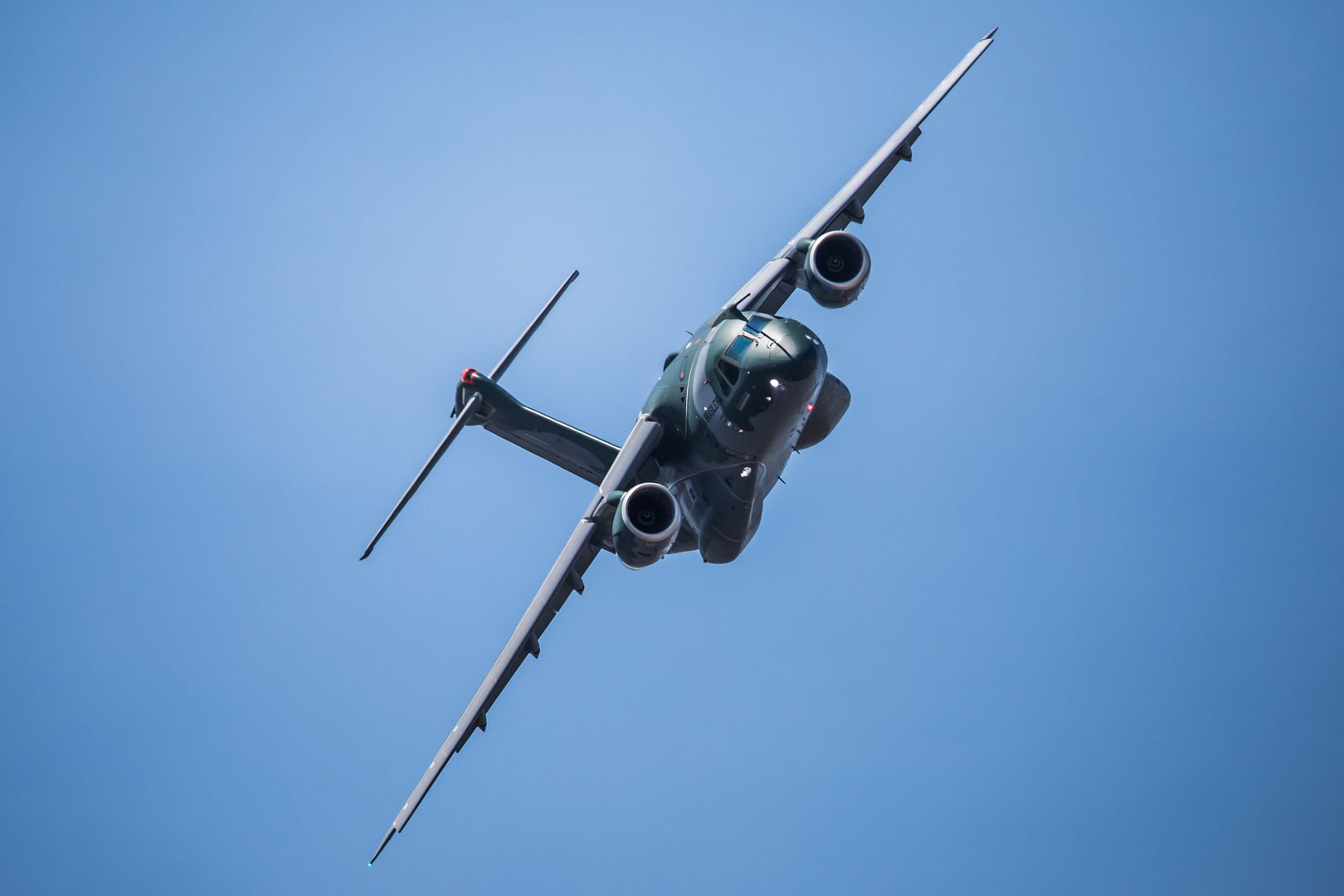
The KC-390 is capable of carrying out various missions, such as transporting cargo, troops or dropping paratroopers, and aerial refueling, search and rescue, medical evacuation and aerial firefighting, in addition to supporting humanitarian missions. The aircraft can transport up to 26 metric tons of cargo at a maximum speed of 470 knots (870 km/h), as well as operate in hostile environments, including from unprepared or damaged runways.
Since the start of the flight test campaign, in October 2015, both KC-390 prototypes have demonstrated high rates of availability, accumulating more than 1,450 flight hours. The Initial Operational Capability should be achieved by the end of this year and first delivery is scheduled to happen in 2018.
-
 Main AdminNAVAL STATION MAYPORT, Fla. (NNS) -- A second U.S. Navy P-8A Poseidon multi-mission maritime aircraft will deploy to Bahia Blanca, Argentina, Nov. 19 to join an ongoing international search for the Argentinean Navy's submarine A.R.A. San Juan in Southern Atlantic waters.
Main AdminNAVAL STATION MAYPORT, Fla. (NNS) -- A second U.S. Navy P-8A Poseidon multi-mission maritime aircraft will deploy to Bahia Blanca, Argentina, Nov. 19 to join an ongoing international search for the Argentinean Navy's submarine A.R.A. San Juan in Southern Atlantic waters.
The aircraft and a crew of 21 personnel will depart Jacksonville, Fla., and are expected to arrive in Argentina the same day.
One Navy P-8A aircraft is already in Argentina, where it joined a NASA P-3 research aircraft already supporting the ongoing search efforts over the submarine's last known location.
Additionally, the U.S. Navy's Undersea Rescue Command (URC), based in San Diego, Calif., is deploying two independent rescue systems that can be used to support underwater search and rescue missions, depending on various oceanic factors, including depth, floor conditions, currents and other safety considerations.
U.S. Southern Command (SOUTHCOM) directed the deployment of the P-8A aircraft, underwater rescue equipment and associated personnel to Argentina to support the country's request for international assistance aimed at locating the missing submarine and crew.
The P-8A Poseidon is the Navy's newest maritime, patrol and reconnaissance aircraft and is configured with state-of-the-art sensors and communications equipment, allowing it to support a wide range of missions over large bodies of water, including sub-surface search-and-rescue operations. It can reach an airspeed of 564 mph, has a ceiling of 41,000 feet and a range of 1,200 nautical miles with four hours on station, allowing it to loiter over search areas.
In April, SOUTHCOM deployed a P-8A Poseidon to Galeo Air Force Base in Rio de Janeiro, Brazil, where it took part in an internationally-supported search for The Republic of Korea ship, Stella Daisy, which tragically sank in the Southern Atlantic, off the western coast of Africa.
In the aftermath of Hurricane Maria in October, P-8A Poseidon aircraft conducted overflight assessment missions, capturing images of conditions on the ground in Dominica to support U.S. foreign disaster assistance operations led by the U.S. Agency for International Development.
SOUTHCOM is one of the nation's six geographically-focused unified commands with responsibility for U.S. military operations in the Caribbean, Central America and South America.
-
6 years agoFri Nov 24 2017, 11:04pm
 Main Admin
Main Admin
A KC-10 Extender assigned to the 380th Air Expeditionary Squadron prepares to take off from Al Dhafra Air Base, United Arab Emirates Nov. 22, 2017. Although the KC-l0's primary mission is aerial refueling, it can combine the tasks of a tanker and cargo aircraft by refueling fighters and simultaneously carry the fighter support personnel and equipment on overseas deployments. (U.S. Air National Guard photo by Staff Sgt. Colton Elliott)
U.S. Airmen with the 455th Expeditionary Aircraft Maintenance Squadron prepare an F-16 fighting falcon assigned to the 77th Fighter Squadron for takeoff Nov. 21, 2017 at Bagram Airfield, Afghanistan. The launch was used in support of a new offensive campaign. Afghan National Defense and Security Forces (ANDSF) and United States Forces-Afghanistan (USFOR-A) launched a series of ongoing attacks to hit the Taliban where they are most vulnerable: their revenue streams. Together, Afghan and U.S. forces conducted combined operations to strike drug labs and command-and-control nodes in northern Helmand province. These types of strikes represent the highest level of trust and cooperation between ANDSF and USFOR-A. (U.S. Air Force photo/Staff Sgt. Divine Cox)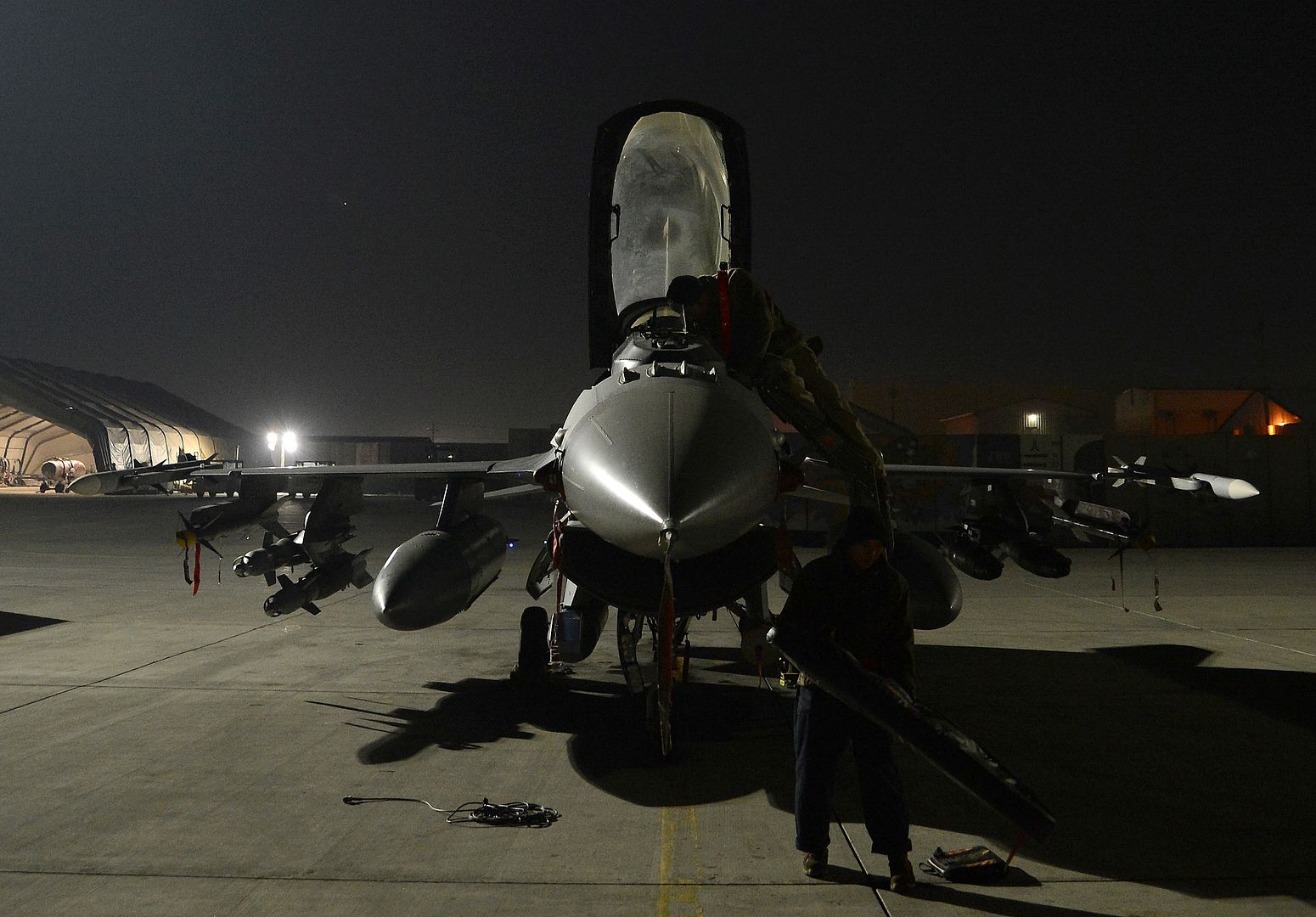
(Source: Australian Department of Defence; issued Nov 24, 2017)
Australia?s third F-35A aircraft has rolled off the assembly line at Lockheed Martin?s production facility in Fort Worth, Texas, marking another major milestone in Australia?s F-35A Project.
Minister for Defence Industry, the Hon Christopher Pyne MP, said No. 3 Squadron markings were applied to the aircraft in early November, the final stage in the production process before the aircraft undergoes several weeks of ground and flight testing at Fort Worth.
?The completion of our third Joint Strike Fighter is a significant achievement for Australia?s F-35A Project,? Minister Pyne said.
?It is particularly exciting that a key component ? the tail piece ? was manufactured in Australia, by Australian company, Marand Engineering.?
?As the programme matures more and more parts on Joint Strike Fighters going to countries around the world will come from Australia.
?More than 50 Australian companies have directly shared in more than $800 million in production contracts thus far, while hundreds more are indirectly benefiting through supply chains.?
Further opportunities for Australian Industry to participate in the F-35 Program through regional assignments for the repair of the second tranche of aircraft components are expected to be announced in 2018.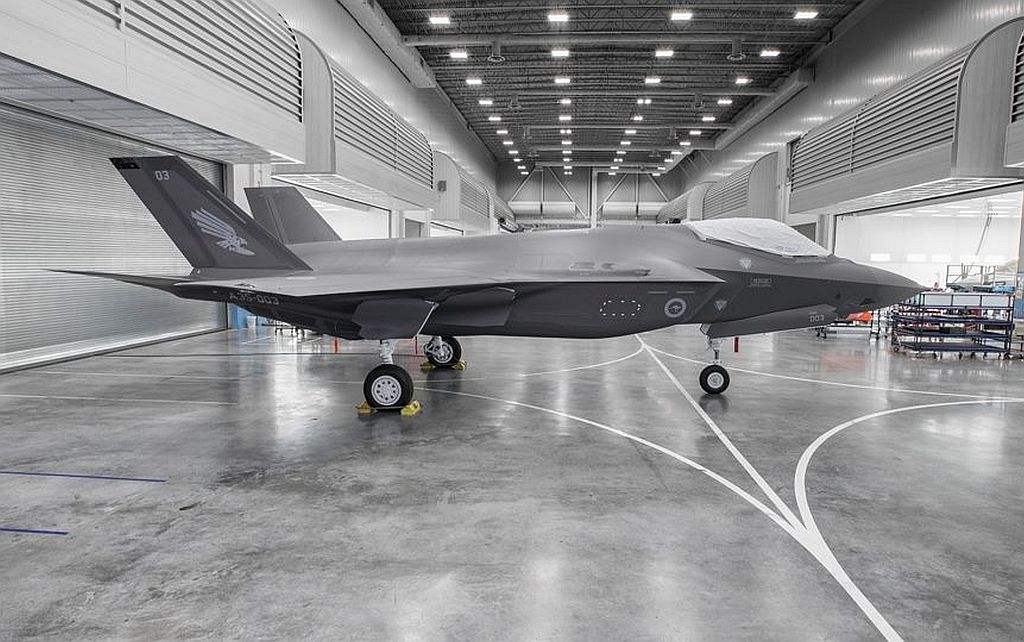
-
 Main AdminUnited States Air Force B-1B Lancers assigned to the 37th Expeditionary Bomb Squadron, deployed from Ellsworth Air Force Base, South Dakota, sit on the flightline prior to a mission at Andersen Air Force Base, Guam, Nov. 27, 2017. Two B-1B bombers took off and transited the south Pacific to Australia where they conducted integrated bilateral training, maintaining contact with Australian Joint Terminal Attack Controllers on the ground over the northern coast of Australia. The integration of U.S. aerial platforms with its allied nations advances and strengthens long-standing military-to-military relationships in the Indo-Asia-Pacific region. (U.S. Air Force photo's/Tech. Sgt. Richard P. Ebensberger)
Main AdminUnited States Air Force B-1B Lancers assigned to the 37th Expeditionary Bomb Squadron, deployed from Ellsworth Air Force Base, South Dakota, sit on the flightline prior to a mission at Andersen Air Force Base, Guam, Nov. 27, 2017. Two B-1B bombers took off and transited the south Pacific to Australia where they conducted integrated bilateral training, maintaining contact with Australian Joint Terminal Attack Controllers on the ground over the northern coast of Australia. The integration of U.S. aerial platforms with its allied nations advances and strengthens long-standing military-to-military relationships in the Indo-Asia-Pacific region. (U.S. Air Force photo's/Tech. Sgt. Richard P. Ebensberger)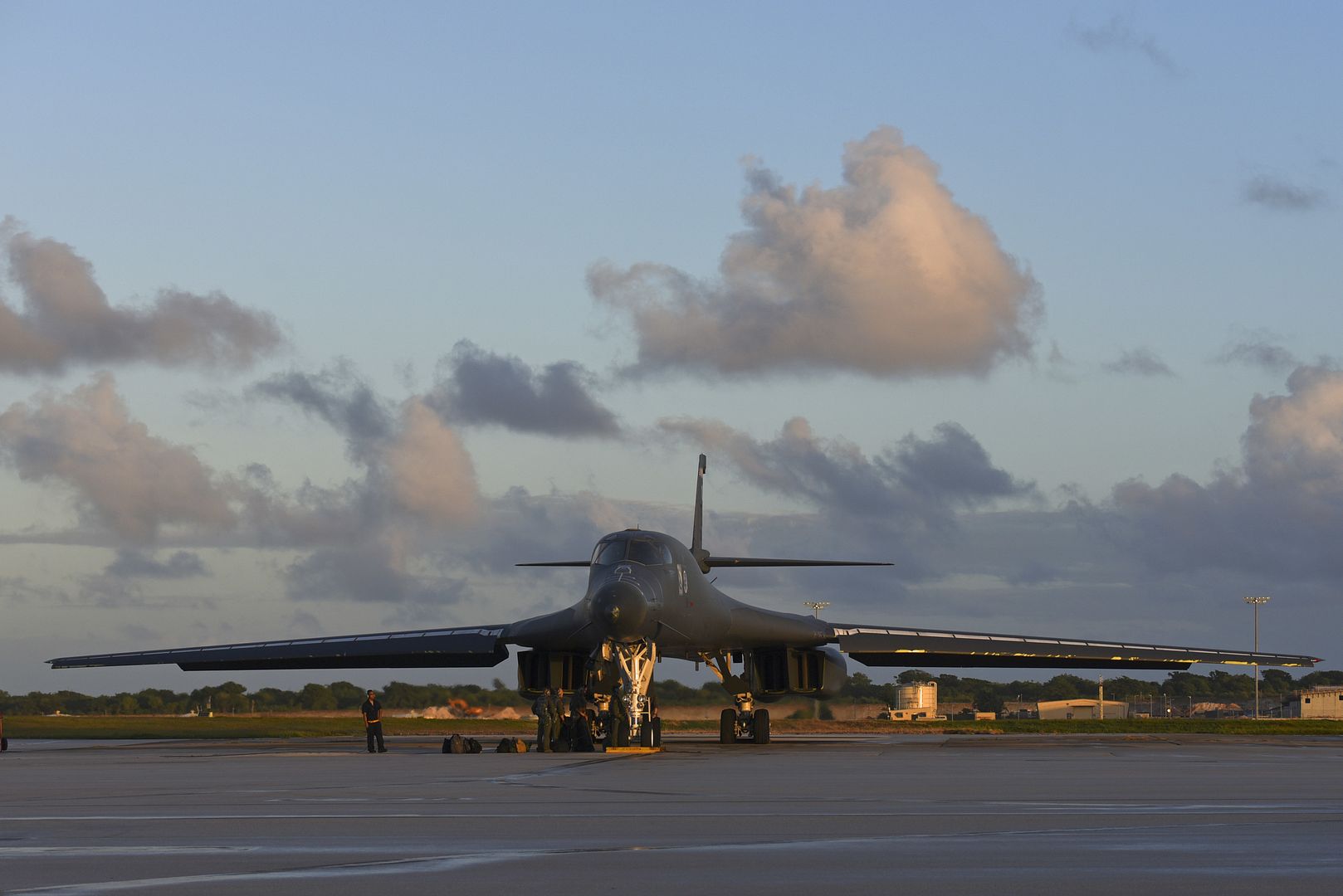
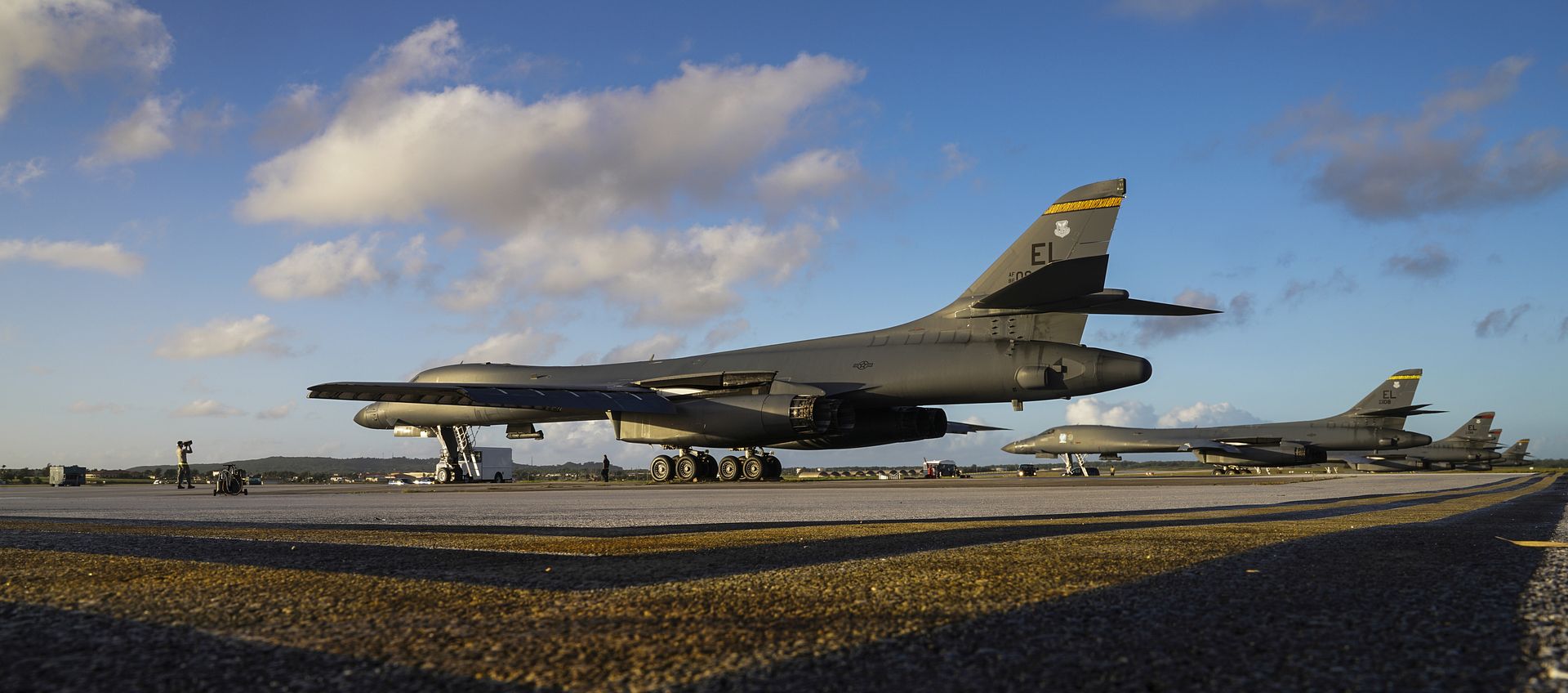
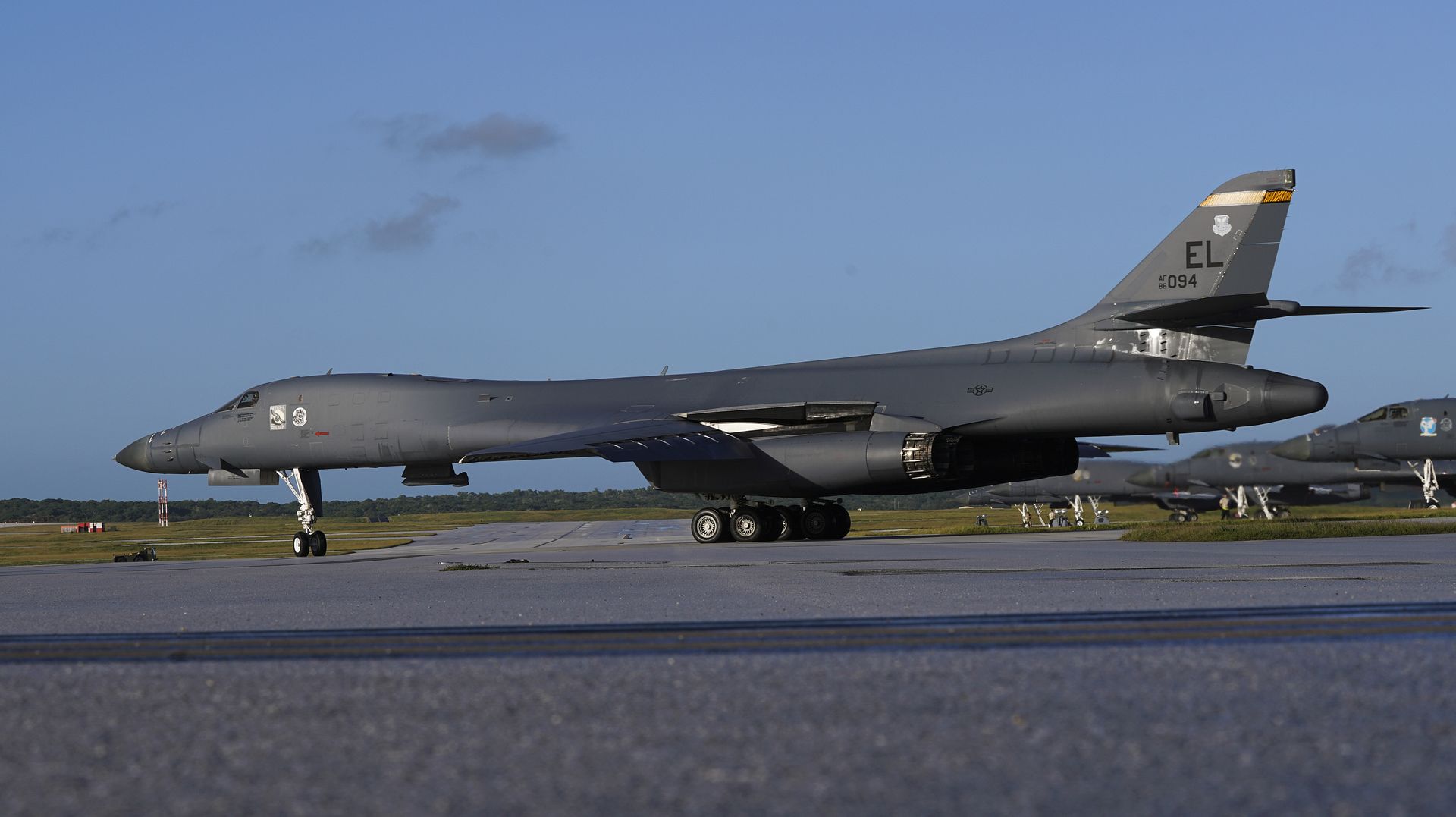
A U.S. Air Force C-130 Hercules takes-off from an expeditionary runway set-up by U.S. Marines with Marine Air Control Squadron 1, Marine Air Traffic Control Mobile Team, during an Angel Thunder exercise in Southern Arizona on Nov. 07, 2017. Angel Thunder is a two-week, Air Combat Command-sponsored, joint-certified and accredited personnel recovery exercise focused on search and rescue. (U.S. Air Force photo by Staff Sgt. Andrew Lee)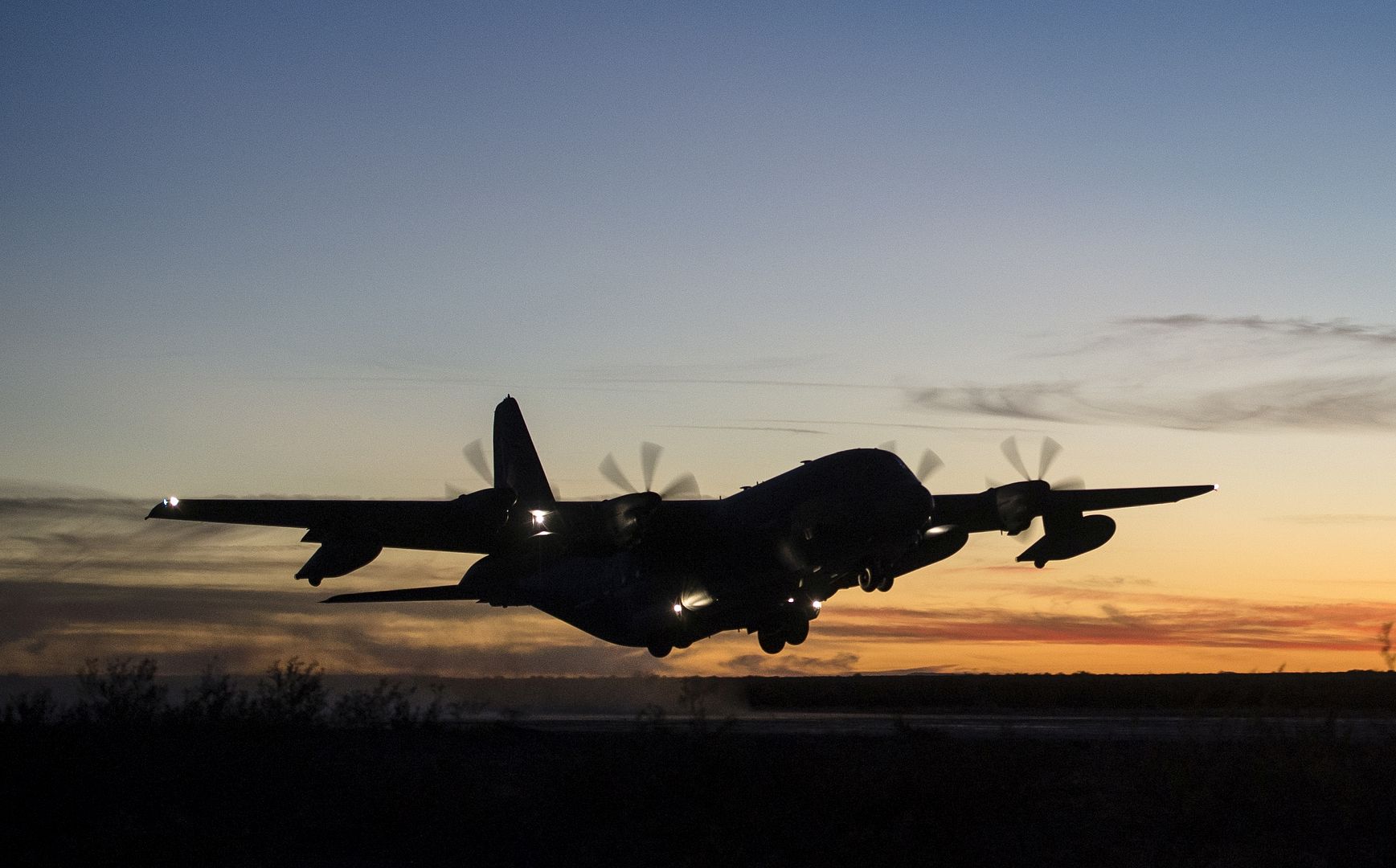
A U.S. Air Force C-130 Hercules lands on an expeditionary runway set-up by U.S. Marines with Marine Air Control Squadron 1, Marine Air Traffic Control Mobile Team, during an Angel Thunder exercise in Southern Arizona on Nov. 07, 2017. Angel Thunder is a two-week, Air Combat Command-sponsored, joint-certified and accredited personnel recovery exercise focused on search and rescue. (U.S. Air Force photo by Staff Sgt. Andrew Lee)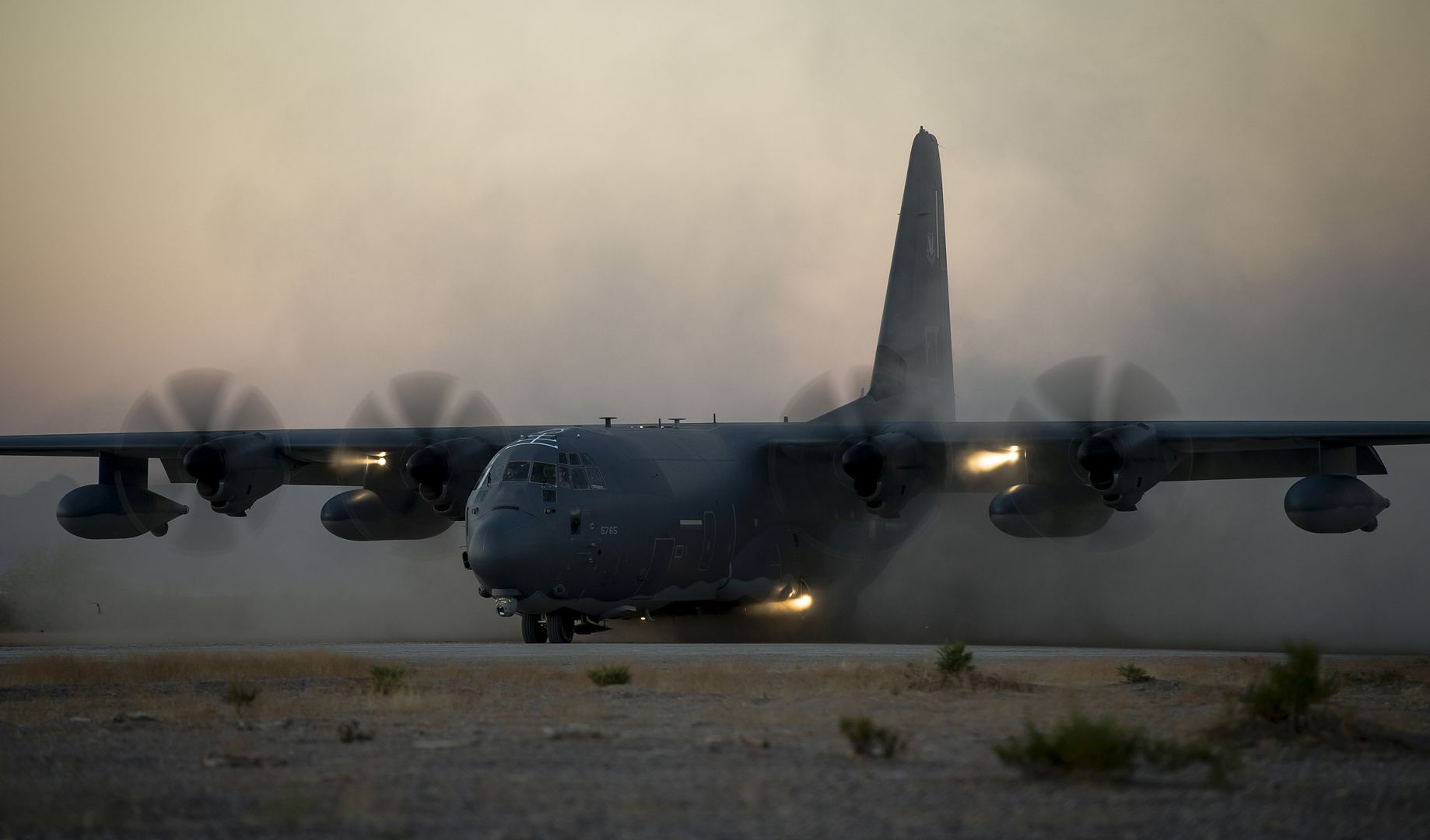
Toulouse, France, 27 November 2017 ? The Airbus Foundation and Air C?te d'Ivoire have organised their first goodwill flight to transport school supplies and clothes for underprivileged children aboard the airline?s newest A320. As part of Air C?te d'Ivoire?s corporate social responsibility policy, this mission will support the education and health sector ? areas in great need in the region.
The aircraft took off from Toulouse on 25 November carrying 3 tonnes of goods, donated by Aviation Sans Fronti?res, to Air C?te d'Ivoire?s home base in Abidjan. The relief items will be distributed to the three NGOs Health Alliance, Children of Africa and SOS Village d?enfants d?Abobo.
?We are honoured to be working with Aviation Sans Fronti?res and the Airbus Foundation to perform this humanitarian flight,? said Ren? D?curey, General Director Air C?te d?Ivoire. ?The acceptance of our latest A320 is made more meaningful as we transport humanitarian goods to children in need. At the same time, this highlights the essential role that aviation plays in addressing humanitarian emergencies and supporting relief operations.?
?Whenever possible with our customers, we try to use delivery flights of new aircraft to ship humanitarian donations to countries or regions in need,? said Fabrice Br?gier, President Airbus Commercial Aircraft and member of the Airbus Foundation?s Board of Directors. ?I welcome Air C?te d'Ivoire to our network of partners and thank the airline as well as Aviation Sans Fronti?res for their logistics support and tireless efforts to make this mission a reality.?
About the Airbus Foundation
The Airbus Foundation, chaired by Tom Enders, CEO of Airbus, includes Airbus, Airbus Helicopters and Airbus Defence and Space as founding and contributing members. It is the company?s vehicle for corporate philanthropy, using the group?s resources, aeronautic and space products, competencies, diverse workforce and culture for driving innovation to address societal issues. In particular, the Foundation supports the global humanitarian community and inspires and prepares young people for the challenges of tomorrow. Since its launch in December 2008, the Airbus Foundation has facilitated more than 60 relief or goodwill flights to numerous destinations around the globe. More information can be found at http://company.airbus.com/responsibility/Foundation.html. Follow us on Twitter: @AirbusFdn
-
 Main AdminA U.S. Air Force B-1B Lancer assigned to 37th Expeditionary Bomber Squadron, deployed from Ellsworth Air Force Base, South Dakota, lands at Royal Australian Air Force Base Amberley, Australia, Nov. 27, 2017. The two B-1B Lancers are participating in RAAF-led exercise Lightning Focus. Lightning Focus is the largest international air forces exercise in Australia. Scheduled to run through Dec. 2, the exercise is intended to provide air-to-air training for pilots, weapons system officers and air battle managers, strengthening military-to-military relationships with our allies and partners. (Royal Australian Air Force photo by LAC Jesse Kane)
Main AdminA U.S. Air Force B-1B Lancer assigned to 37th Expeditionary Bomber Squadron, deployed from Ellsworth Air Force Base, South Dakota, lands at Royal Australian Air Force Base Amberley, Australia, Nov. 27, 2017. The two B-1B Lancers are participating in RAAF-led exercise Lightning Focus. Lightning Focus is the largest international air forces exercise in Australia. Scheduled to run through Dec. 2, the exercise is intended to provide air-to-air training for pilots, weapons system officers and air battle managers, strengthening military-to-military relationships with our allies and partners. (Royal Australian Air Force photo by LAC Jesse Kane)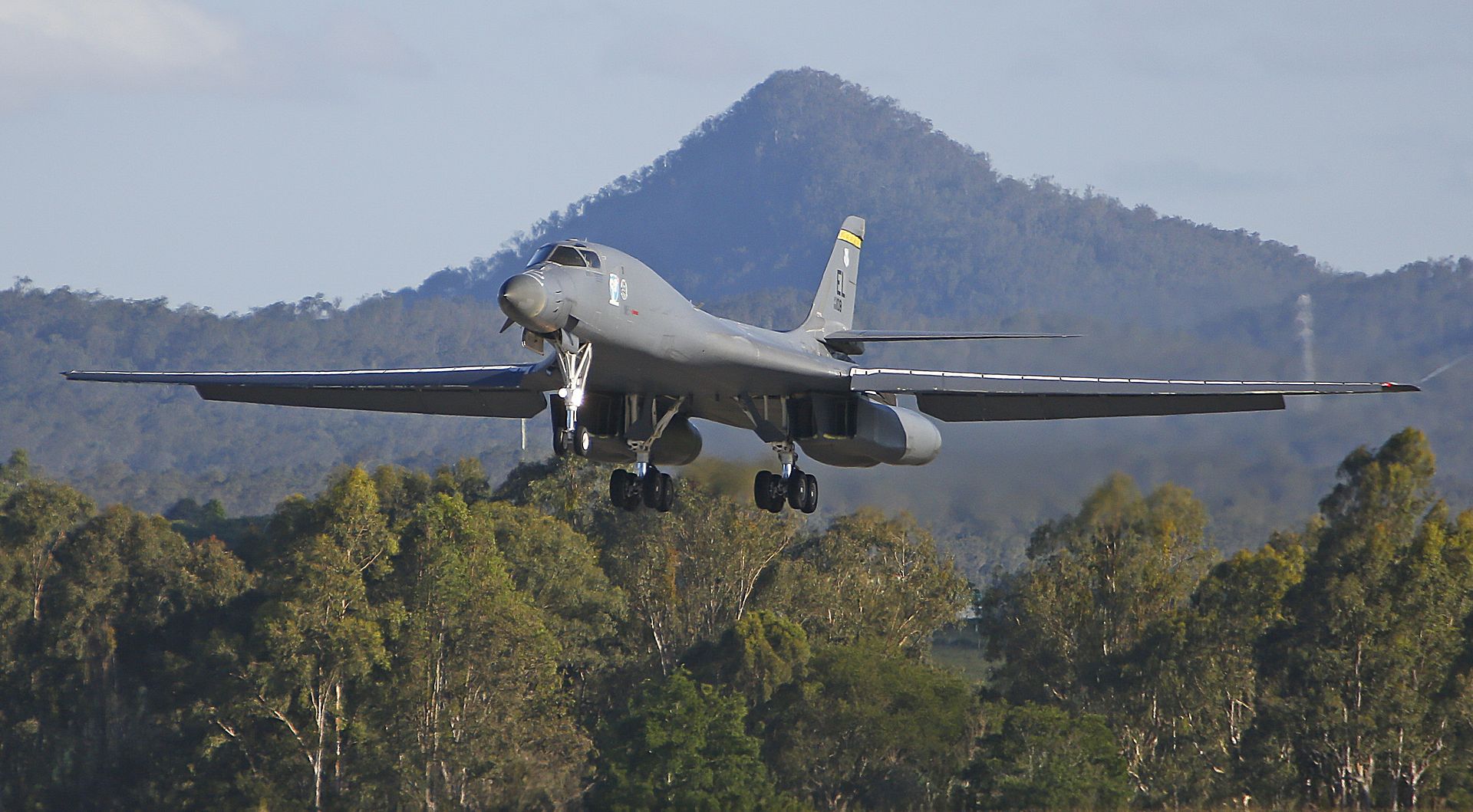
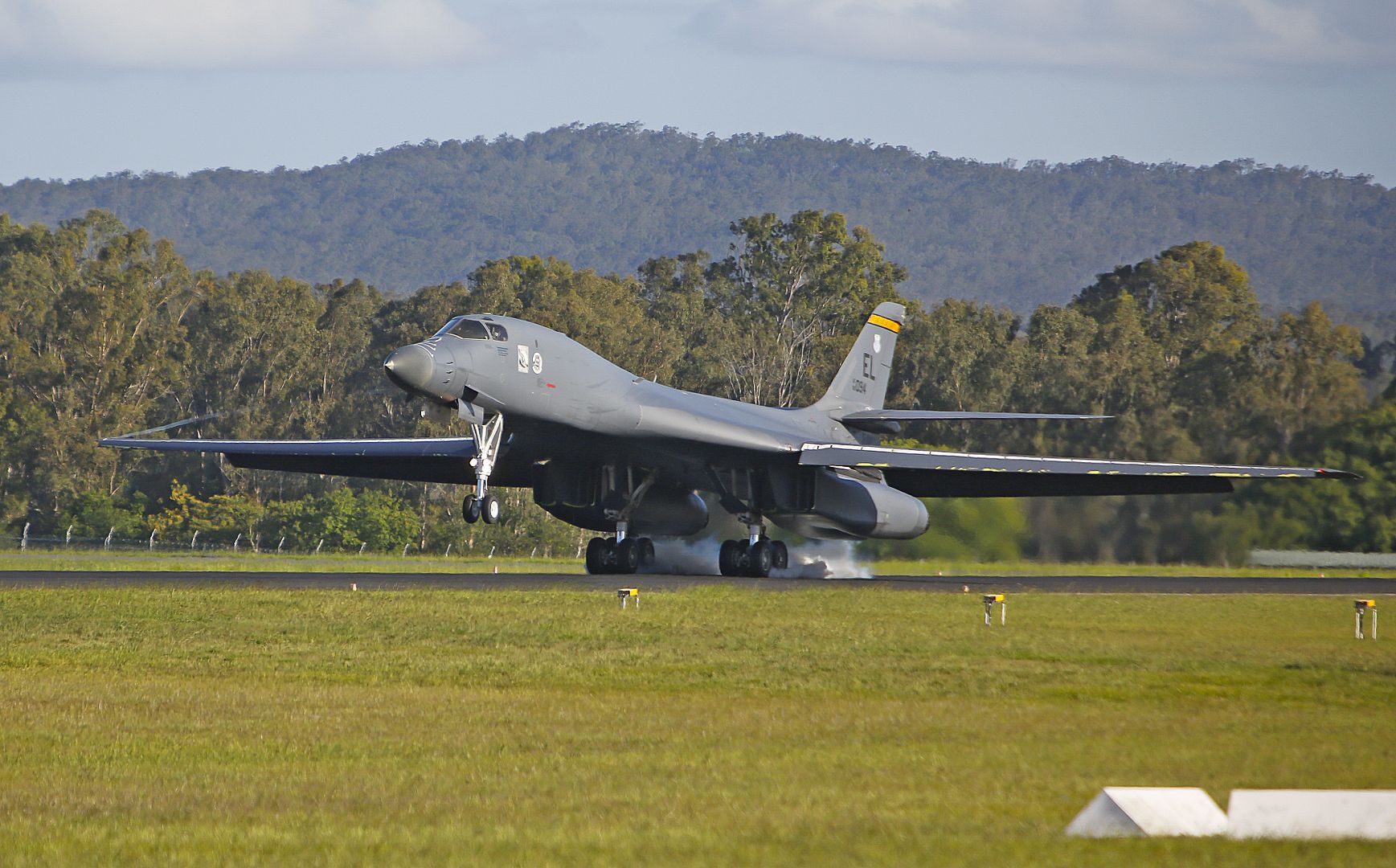
QF-4E Phantom II, serial # 72-0159, with tail-hook and landing gear down during a simulated approach during a training mission near Tyndall AFB, FL. The aircraft is piloted by Mr. Matt LaCourse, a contract pilot employed by Lockheed Martin to support the full-scale aerial target program operated by the USAF's 82nd Aerial Targets Squadron (ATRS), 53rd Weapons Evaluation Group (WEG) at Tyndall AFB, FL. LaCourse is a retired Lieutenant Colonel who flew the F-4 and F-16s operationally during his career. The aircraft wears high-visilibity 'drone' markings with brigh-painted panels on the tail, wings and horizontal stabilizers. The 82nd falls under the USAF's warfighting command--Air Combat Command. This aircraft was retired from service to AMARC on 26 Apr. 1991. BAE Systems of Mojave, CA. has returned it to service as a full-scale aerial target. Photographed on 18 Nov. 2008. (Courtesy photo's by Greg L. Davis, Aviation Photojournalist)
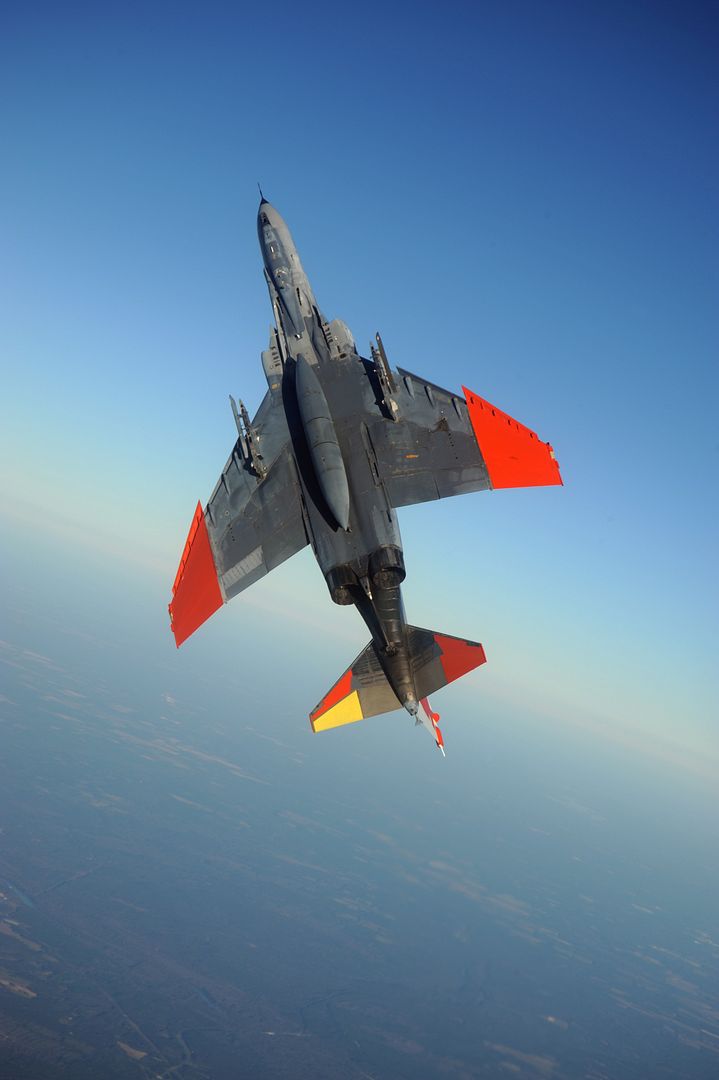
An EA-18G Growler with Electronic Attack Squadron (VAQ) 141 taxis to a hangar at Marine Corps Air Station (MCAS) Iwakuni, Japan, Nov. 28, 2017. VAQ-141 arrived at MCAS Iwakuni as part of Carrier Air Wing (CVW) 5?s relocation from Naval Air Facility (NAF) Atsugi, Japan. The relocation of CVW-5 from NAF Atsugi to MCAS Iwakuni fulfills the final Defense Policy Review Initiative objective. The relocation is in accordance with the United States? strategic vision for the rebalance in the Indo-Asia Pacific Region and does much to further strengthen the U.S.-Japan security alliance. (U.S. Marine Corps photo by Cpl. Joseph Abrego)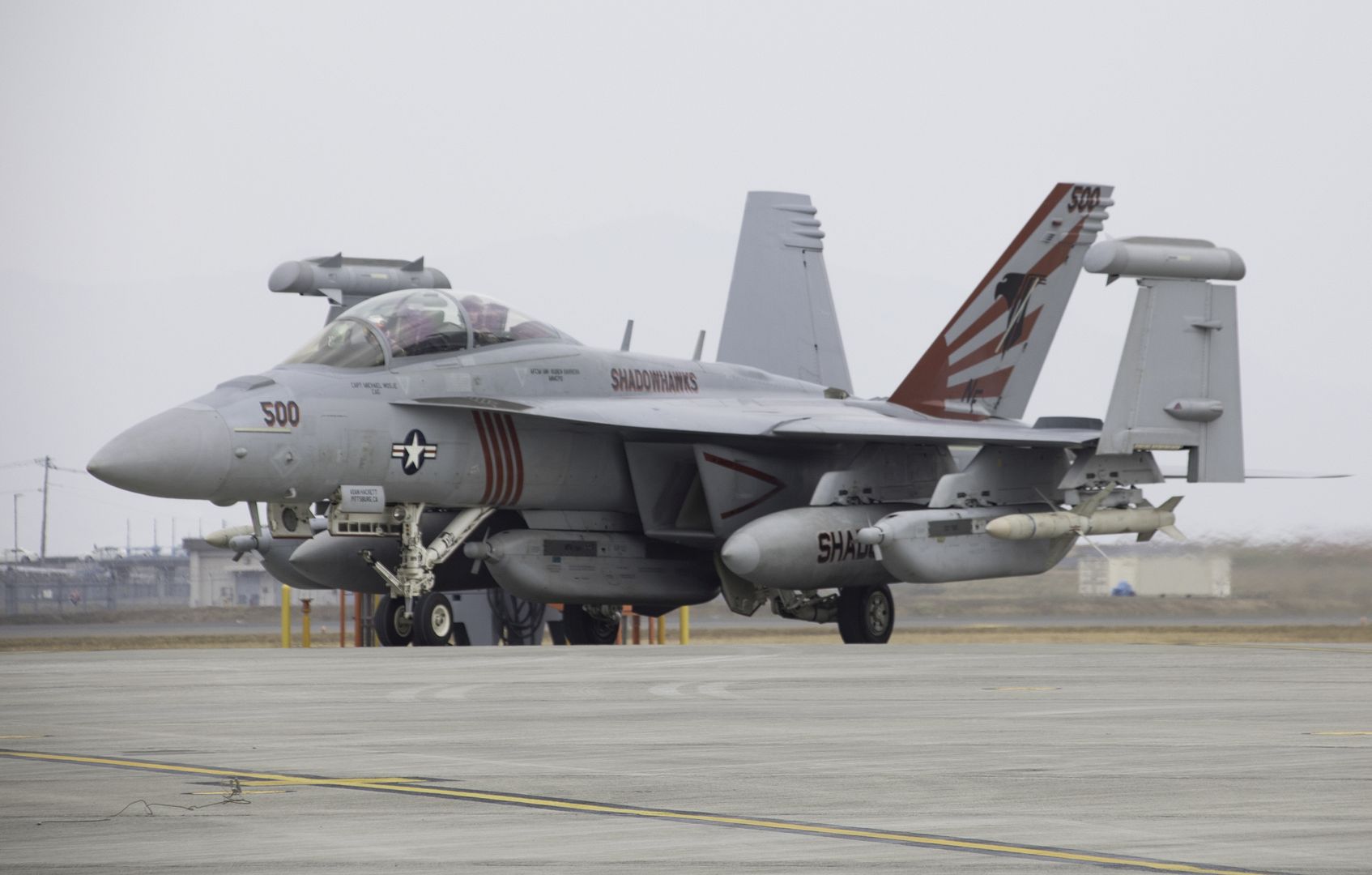
An F/A-18E Super Hornet with Strike Fighter Squadron (VFA) 115 prepares to land at Marine Corps Air Station (MCAS) Iwakuni, Japan, Nov. 28, 2017. VFA-115 arrived at MCAS Iwakuni as part of Carrier Air Wing (CVW) 5?s relocation from Naval Air Facility (NAF) Atsugi, Japan. The relocation of CVW-5 from NAF Atsugi to MCAS Iwakuni fulfills the final Defense Policy Review Initiative objective. The relocation is in accordance with the United States? strategic vision for the rebalance in the Indo-Asia Pacific Region and does much to further strengthen the U.S.-Japan security alliance. (U.S. Marine Corps photo by Cpl. Donato Maffin)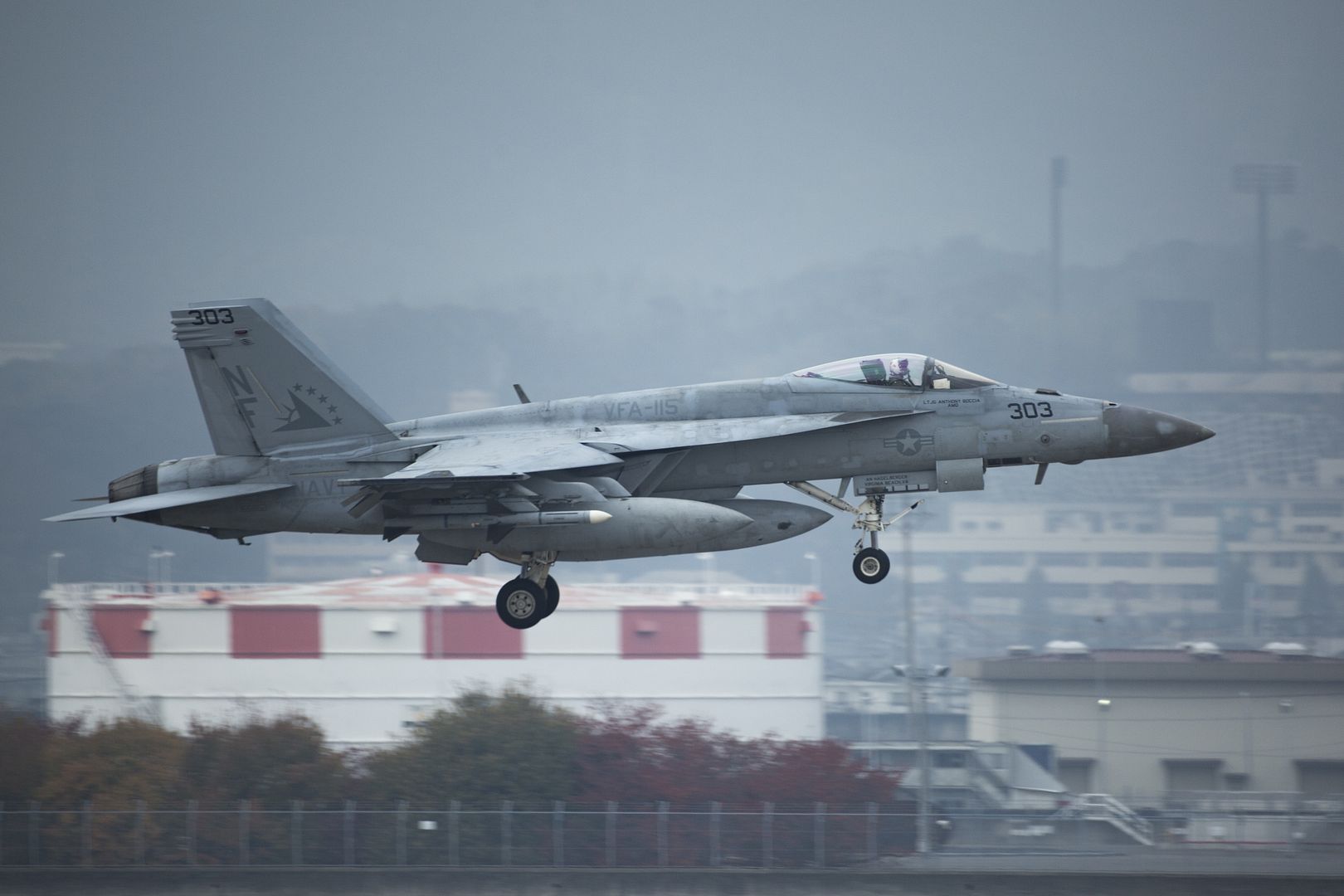
An F/A-18E Super Hornet with Strike Fighter Squadron (VFA) 115 prepare to land at Marine Corps Air Station (MCAS) Iwakuni, Japan, Nov. 28, 2017. VFA-115 arrived at MCAS Iwakuni as part of Carrier Air Wing (CVW) 5?s relocation from Naval Air Facility (NAF) Atsugi, Japan. The relocation of CVW-5 from NAF Atsugi to MCAS Iwakuni fulfills the final Defense Policy Review Initiative objective. The relocation is in accordance with the United States? strategic vision for the rebalance in the Indo-Asia Pacific Region and does much to further strengthen the U.S.-Japan security alliance. (U.S. Marine Corps photo by Cpl. Donato Maffin)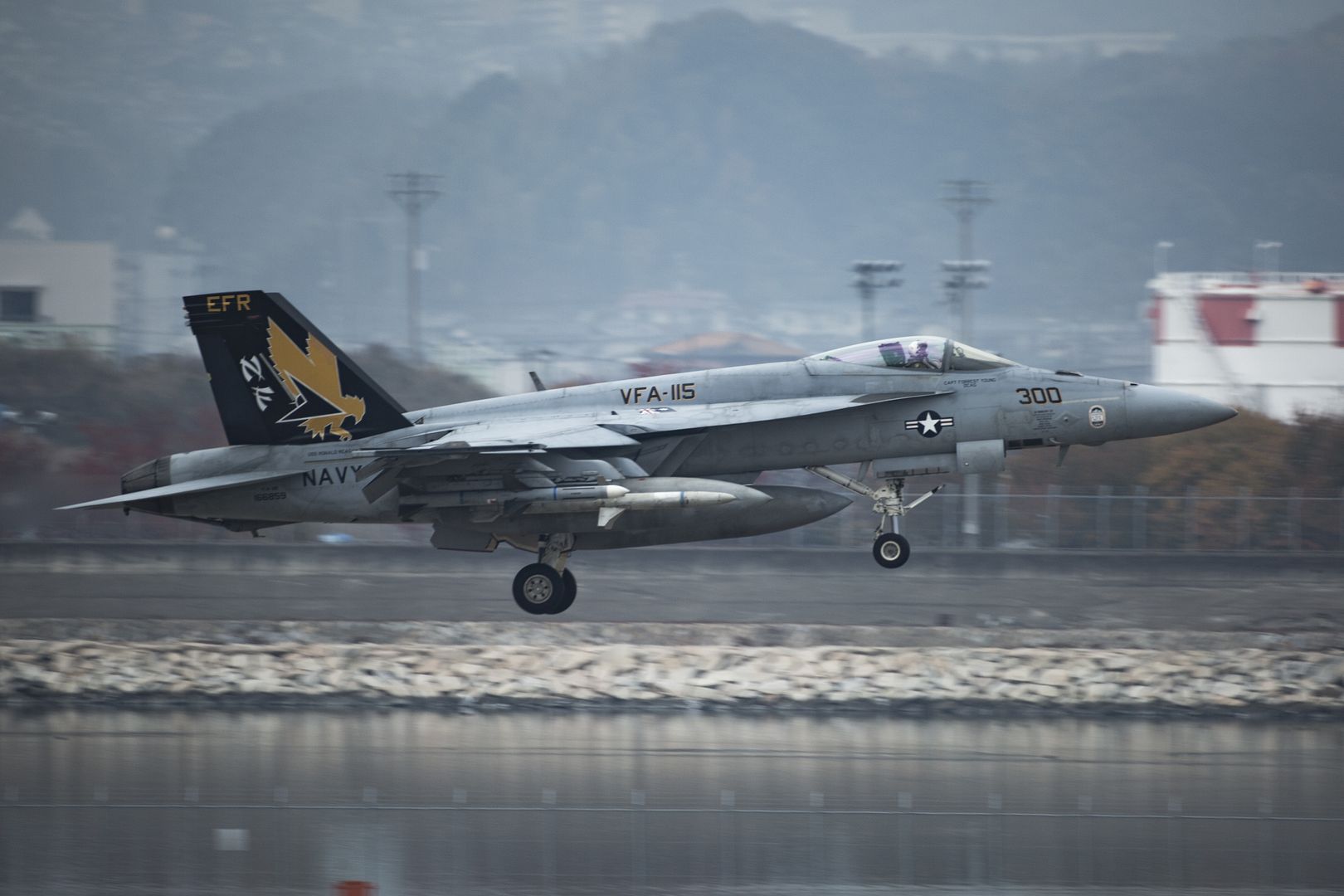
An EA-18G Growler with Electronic Attack Squadron (VAQ) 141 lands at Marine Corps Air Station (MCAS) Iwakuni, Japan, Nov. 28, 2017. VAQ-141 arrived at MCAS Iwakuni as part of Carrier Air Wing (CVW) 5?s relocation from Naval Air Facility (NAF) Atsugi, Japan. The relocation of CVW-5 from NAF Atsugi to MCAS Iwakuni fulfills the final Defense Policy Review Initiative objective. The relocation is in accordance with the United States? strategic vision for the rebalance in the Indo-Asia Pacific Region and does much to further strengthen the U.S.-Japan security alliance. (U.S. Marine Corps photo by Cpl. Donato Maffin)
ATLANTIC OCEAN (Nov. 24, 2017) A U.S. Marine Corps AV-8B Harrier assigned to Marine Medium Tiltrotor Squadron (VMM) 162 (Reinforced), 26th Marine Expeditionary Unit (MEU), takes off from the amphibious assault ship USS Iwo Jima (LHD 7) as part of combined composite training unit exercise (COMPTUEX) in the Atlantic Ocean. The exercise allows all elements of the Marine Air Ground Task Force (MAGTF) to join and train in realistic scenarios so the MEU as a whole can meet its pre-deployment training program objectives prior to their upcoming deployment at sea. (U.S. Marine Corps photo by Cpl. Jon Sosner/Released)
Fairbanks, Alaska, Nov. 27, 2017 ? Maj. Jonathan ?Spades? Gilber, U.S. Air Force F-35 test pilot, demonstrates the handling qualities of Lockheed Martin?s (NYSE: LMT) F-35 Lightning II during icy runway ground testing at Eielson Air Force Base, Alaska. The testing is part of the certification process for the Norwegian drag chute and continues over the next several weeks. Maj. Eskil Amdal, test pilot with the Royal Norwegian Air Force, is also participating.
This initial testing is the first of two phases to ensure the F-35A can operate in these extreme conditions. The second phase of testing will deploy the Norwegian drag chute during landing operations and is planned for first quarter 2018 at Eielson.
About the Norwegian F-35 Drag Chute
The F-35A drag chute is designed to be installed on all of Norway?s F-35As and is form fitted to ensure it maintains stealth characteristics while flying. Norway and Lockheed Martin are working with the Netherlands who is sharing in the development of this critical capability. The drag chute underwent initial wet and dry runway deployment testing at Edwards Air Force Base, California earlier this year.
Donauw?rth, The second prototype of the NH90 Sea Lion commissioned by the Federal Office of Bundeswehr Equipment, Information Technology and In-Service Support (Bundesamt f?r Ausr?stung, Informationstechnik und Nutzung der Bundeswehr) lifted off from the Donauw?rth site for its maiden flight on 24 November 2017. Airbus Helicopters is now entering a development testing phase of several months that will focus on avionics and software. Activities for the qualification of the delivery configuration will start over the course of 2018 once additional modifications have been made to the prototype. Despite the very demanding timetable, the company is convinced that deliveries to the German Navy will start at the end of 2019. Final assembly of the first Sea Lion seriesproduction aircraft also started recently; this will run in parallel to the qualification.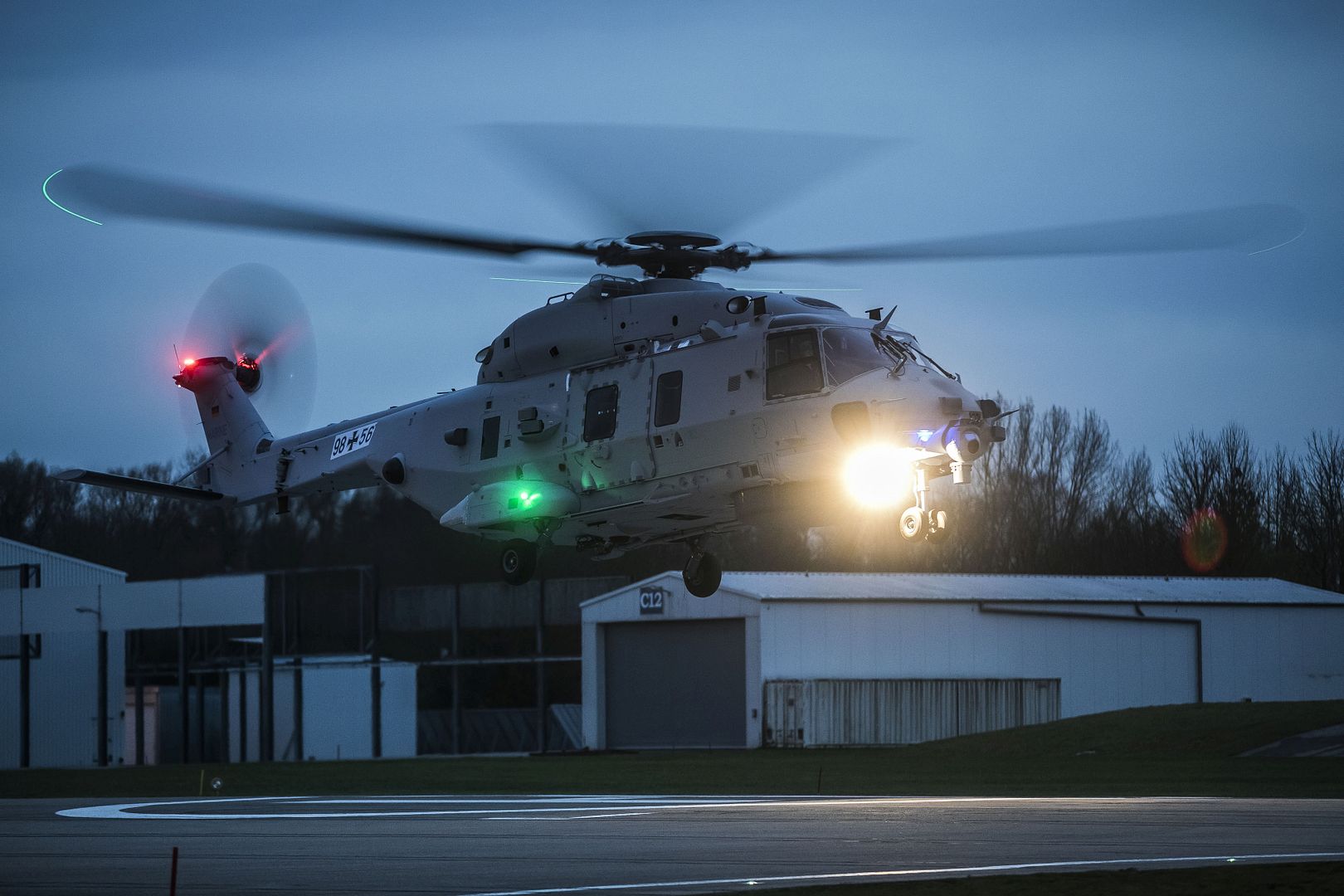
RAF Typhoon Fighter jets from the UK will be seen and heard over Qatar this week as part of a joint exercise being held with the Emir of Qatar's Air Force.
The exercise will enable Royal Air Force air and ground crews to pass on their experience of flying and maintaining the world-class Typhoon aircraft to their Qatari counterparts.
During this week the Qatari pilots will test their combat skills in their Mirage Jets against the British pilots flying Typhoon, and get to learn about the impressive capabilities and weapons systems of the aircraft which have been proven to be highly successful on RAF operations in recent times.
The Government of Qatar has signed a Statement of Intent to re-equip the country's fighter force with 24 UK built Typhoons and many of the QEAF pilots involved in the week-long exercise will be amongst the first to be trained to fly them in Great Britain.
-
 Main AdminA CH-53E Super Stallion with Marine Heavy Helicopter Training Squadron (HMHT) 302, 2nd Marine Aircraft Wing prepares to pick up practice materials during Helicopter Support Team training with Combat Logistics Battalion 6, 2nd Marine Logistics Group at Camp Lejeune, N.C., Nov. 28, 2017. A Helicopter Support Team is comprised of approximately eight landing support specialist Marines who ensure the equipment is properly attached and secured before pilots transport the gear or supplies to their destination. (U.S. Marine Corps photo by Cpl. Aaron Henson)
Main AdminA CH-53E Super Stallion with Marine Heavy Helicopter Training Squadron (HMHT) 302, 2nd Marine Aircraft Wing prepares to pick up practice materials during Helicopter Support Team training with Combat Logistics Battalion 6, 2nd Marine Logistics Group at Camp Lejeune, N.C., Nov. 28, 2017. A Helicopter Support Team is comprised of approximately eight landing support specialist Marines who ensure the equipment is properly attached and secured before pilots transport the gear or supplies to their destination. (U.S. Marine Corps photo by Cpl. Aaron Henson)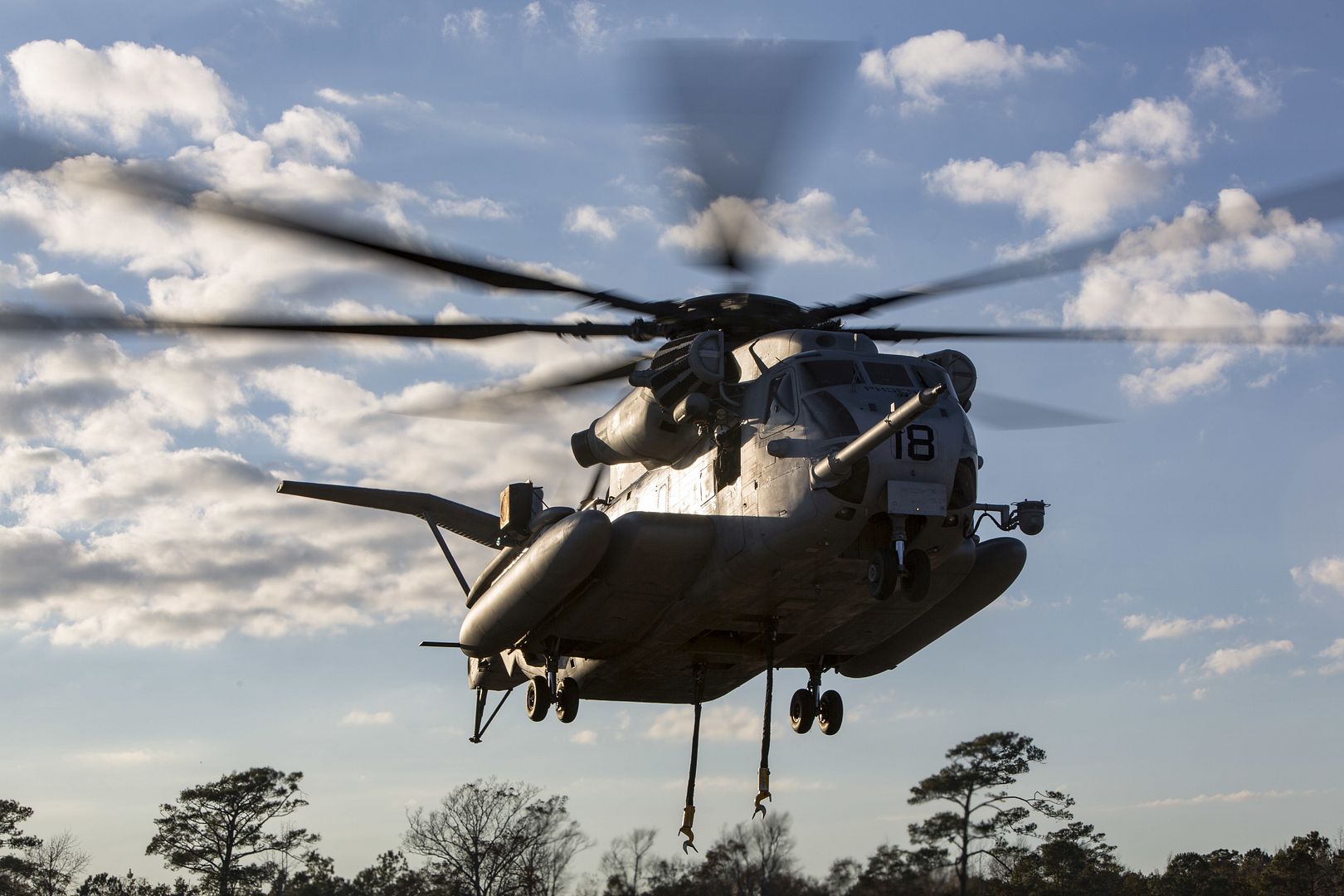
An Air Force C-130 Hercules is parked at Young Air Assault Strip on Nov. 28, 2017, on South Post at Fort McCoy, Wis. The C-130, which arrived at the airstrip in October 2015, was transferred from Little Rock Air Force Base, Ark., to Fort McCoy. The aircraft eventually is used to train service members to palletize cargo. The aircraft is located permanently at the airstrip. A full enclosure was built to provide for a more-defined training area. (U.S. Army Photo by Scott T. Sturkol, Public Affairs Office, Fort McCoy, Wis.)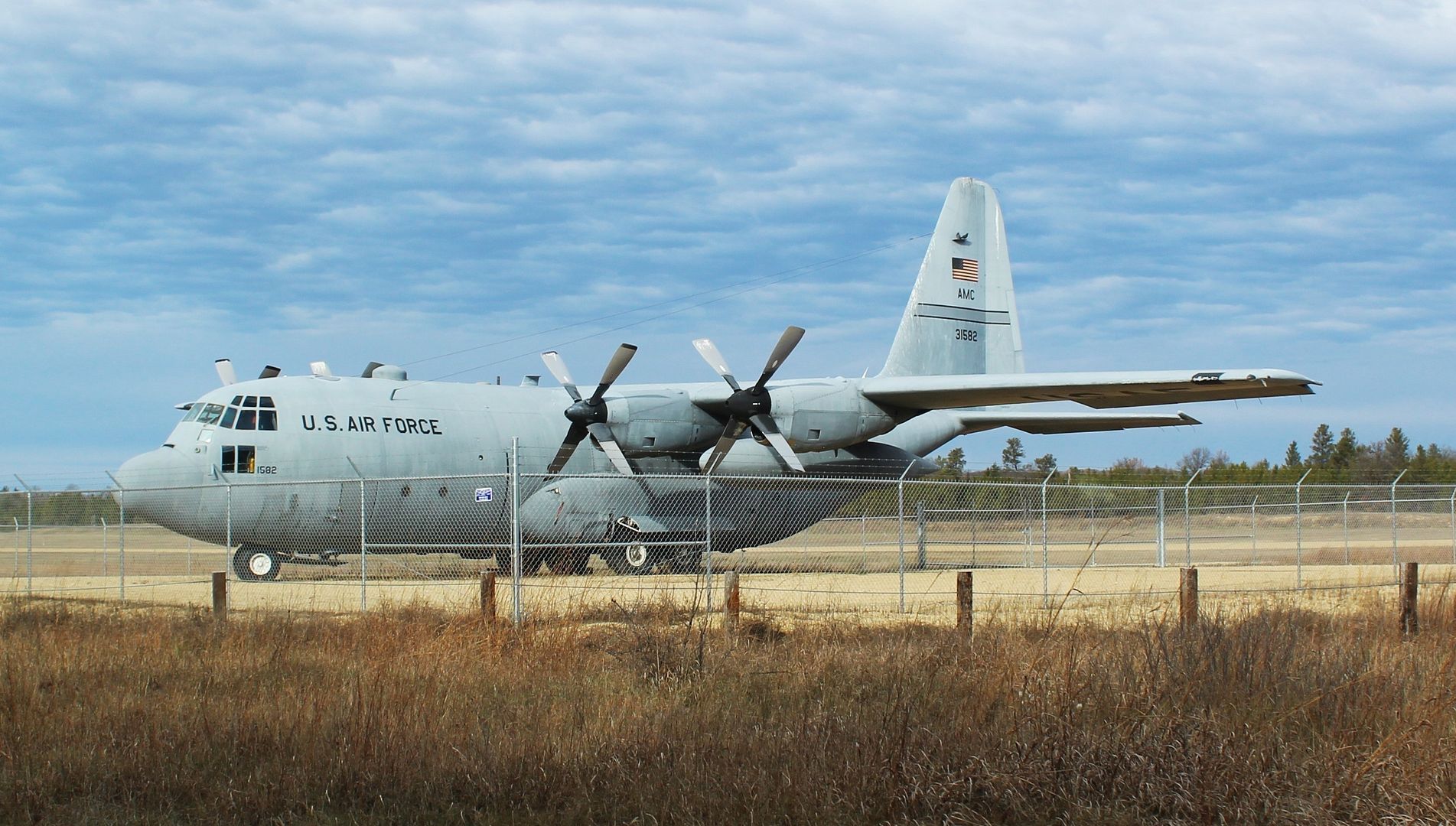
KUNSAN AIR BASE, Republic of Korea --
The 8th Fighter Wing conducted a large force employment drill in which the 35th and 80th launched more than 20 aircraft to test its ability to conduct combat operations with a large number of aircraft in the air on November 17, 2018. The 8th FW regularly train using these procedures giving the pilots, maintainers and supporting personnel the opportunity to practice generating aircraft as quickly as possible.
A U.S. Air Force F-16 Fighting Falcon with the 80th Fighter Squadron uses its afterburner to take off at Kunsan Air Base, Republic of Korea, Nov. 17, 2017, while a pilot with the 35th FS taxis to take off behind. The two fighter squadrons carry out a wide variety of combat sorties in support of contingency operation plans on the Korean Peninsula. These aircraft took part in a large force employment involving more than 20 aircraft to test their ability to conduct such missions. (U.S. Air Force photo by Capt. Christopher Mesnard)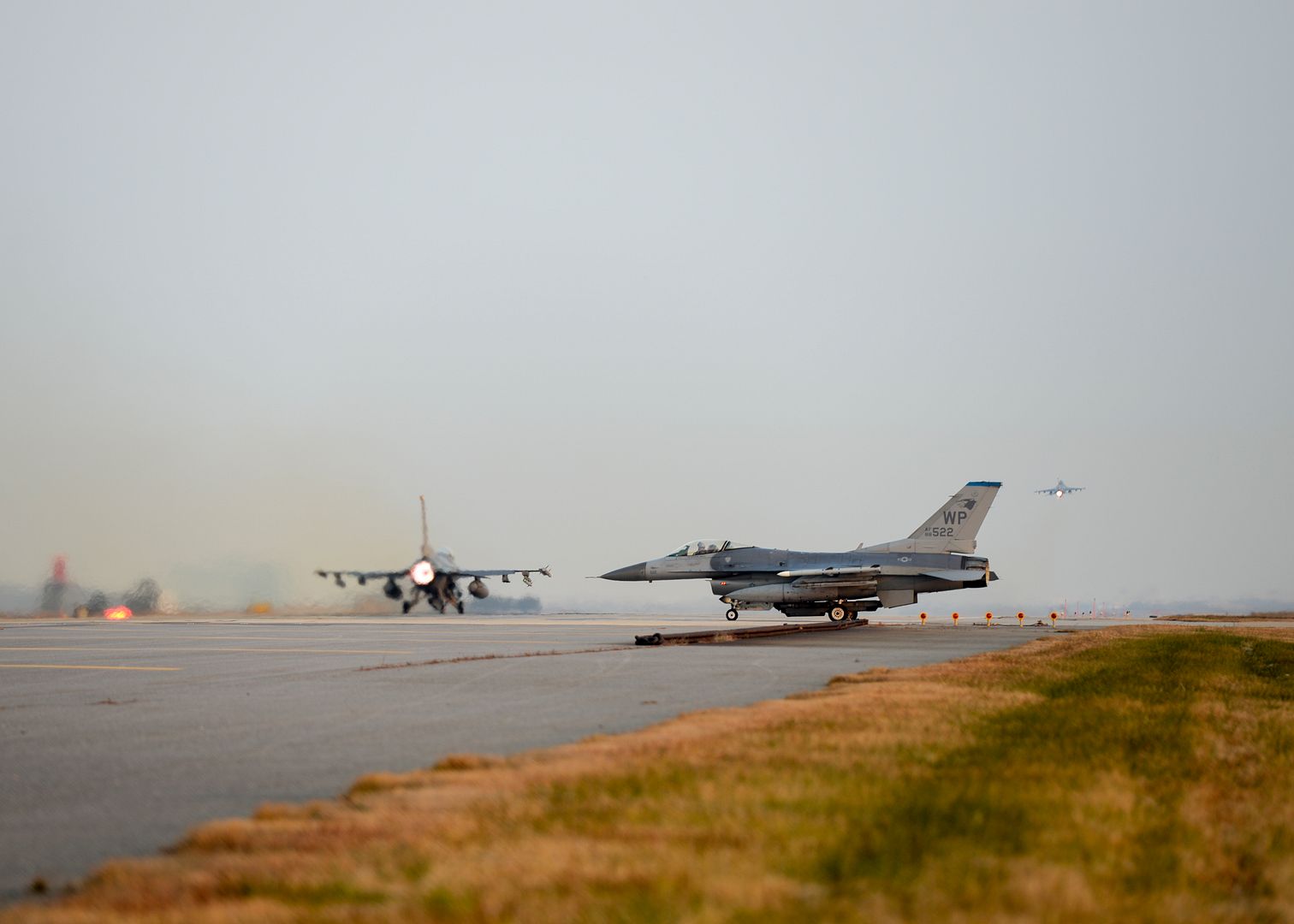
A U.S. Air Force F-16 Fighting Falcon with the 80th Fighter Squadron takes off from Kunsan Air Base, Republic of Korea, Nov. 17, 2017 during a large force employment drill in which the 8th Fighter Wing launched more than 20 jets, testing the combat operations with a larger number of aircraft. The 8th FW regularly tests its ability to launch a large number of jets in a short amount of time. (U.S. Air Force photo by Senior Airman Colby L. Hardin)
IWAKUNI, Japan (Nov. 28, 2017) An EA-18G Growler with Electronic Attack Squadron (VAQ) 141 prepares to land at Marine Corps Air Station (MCAS) Iwakuni, Japan. The relocation of CVW-5 from NAF Atsugi to MCAS Iwakuni fulfills the final Defense Policy Review Initiative objective. The relocation is in accordance with the United States' strategic vision for the rebalance in the Indo-Asia Pacific Region and does much to further strengthen the U.S.-Japan security alliance. (U.S. Marine Corps photo by Cpl. Donato Maffin/Released)
November 29, 2017 Toronto Commercial Aircraft, Press Release
Bombardier Commercial Aircraft announced today that CemAir (PTY) Ltd of South Africa has concluded a firm purchase agreement for two new Q400 turboprops, and has also signed the lease of a used Q400 aircraft that was delivered this month, paving the way for the new aircraft to be delivered afterwards. The letter of Intent (LOI) from CemAir, which was signed on June 21 at the 2017 Paris Air Show, has now been converted into a firm order.
Based on the list price of the Q400 aircraft, the firm order is valued at approximately $66 million US.
?We are delighted that CemAir has selected the Q400 aircraft to expand its fleet?, said Jean-Paul Boutibou, Vice President, Sales, Middle-East and Africa at Bombardier Commercial Aircraft. ?The Q400 is the next natural step in the growth of CemAir?s fleet of Bombardier CRJ Series and Q Series aircraft, as it brings more flexibility to increase the capacity on key routes while their aircraft?s superior performance and unbeatable economics support CemAir?s growing market position against competitive forces. The Q400 will open several market opportunities to CemAir on domestic and future regional routes.?
?CemAir has enjoyed significant growth in the last few years and this has come from our focused approach on selecting the right aircraft for our operation?, said Miles van der Molen, CEO, CemAir. ?The Q400 is a fantastic performer especially in our environment of high altitudes and hot operating temperatures. It is really an unbeatable turboprop that brings so many jet-like features to ensure a competitive and operational advantage in our market. We see the Q400 as the ideal growth solution for our scheduled and charter operations as we continue to strengthen our relationship with Bombardier. We are working to expand our scheduled operations beyond South Africa and continuing to support new opportunities across the continent.?
With these Q400 aircraft, CemAir would increase its current fleet of Bombardier aircraft to 17 ? including five Q Series turboprops and 12 CRJ Series aircraft. CemAir recently added a used CRJ900 aircraft to its fleet, the first in South Africa.
Bombardier Commercial Aircraft already has a solid foothold on the African continent with upwards of 190 Q Series turboprops ? including over 35 Q Series operators ? and CRJ regional jets in operation or on order from customers. Over the next two decades, Africa is expected to take deliveries of 550 new aircraft, and with Bombardier?s family of aircraft, the company is well positioned to serve this growing market.
About CemAir
As an IOSA certified airline and full member of IATA, CemAir operates a domestic and regional airline service in and around South Africa. The airline owns and operates a fleet of 21 regional aircraft including the Bombardier CRJ 100/200, the Bombardier Dash-8 Q300 and Dash-8 Q100 and the Beechcraft 1900D. The Company also offers flexible, value added, short, medium or long-term leasing of these aircraft structured to include full maintenance and operational support with quality and safety oversight for a broad spectrum of regional airline carriers, aid organisations and resource companies.
CemAir has experience in operating and supporting aircraft in a variety of conditions, with an emphasis on maintaining first world standards in third world environments. Cemair strives to achieve high levels of reliability through the application of constantly evolving internationally recognized standards. CemAir?s objective is to place properly prepared equipment, well-qualified crew and the use of appropriate current technologies at the disposal of the customer.
The company has operating and leasing experience throughout Africa and the Middle East, including Afghanistan, Tunisia, Libya, Sudan, Tanzania, Democratic Republic of Congo, Senegal, Kenya, Mali, Gabon, Ghana, Namibia, Botswana, Mozambique, Nigeria, South Sudan, Zambia, as well as South Africa.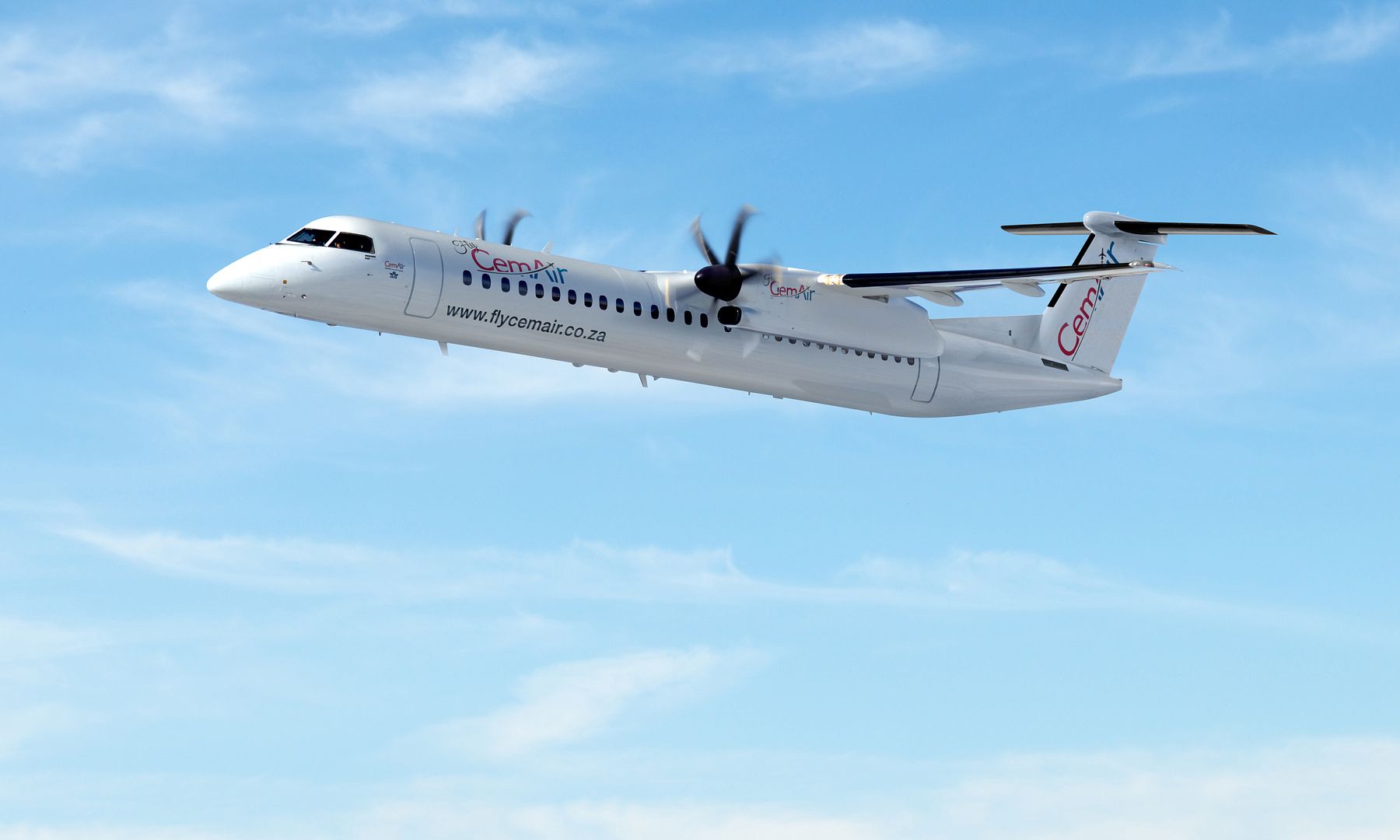
Post a reply
- Go to Previous topic
- Go to Next topic
- Go to Welcome
- Go to Introduce Yourself
- Go to General Discussion
- Go to Screenshots, Images and Videos
- Go to Off topic
- Go to Works in Progress
- Go to Skinning Tips / Tutorials
- Go to Skin Requests
- Go to IJAAF Library
- Go to Luftwaffe Library
- Go to RAF Library
- Go to USAAF / USN Library
- Go to Misc Library
- Go to The Ops Room
- Go to Made in Germany
- Go to Campaigns and Missions
- Go to Works in Progress
- Go to Juri's Air-Raid Shelter
- Go to Campaigns and Missions
- Go to Works in Progress
- Go to Skinpacks
- Go to External Projects Discussion
- Go to Books & Resources
